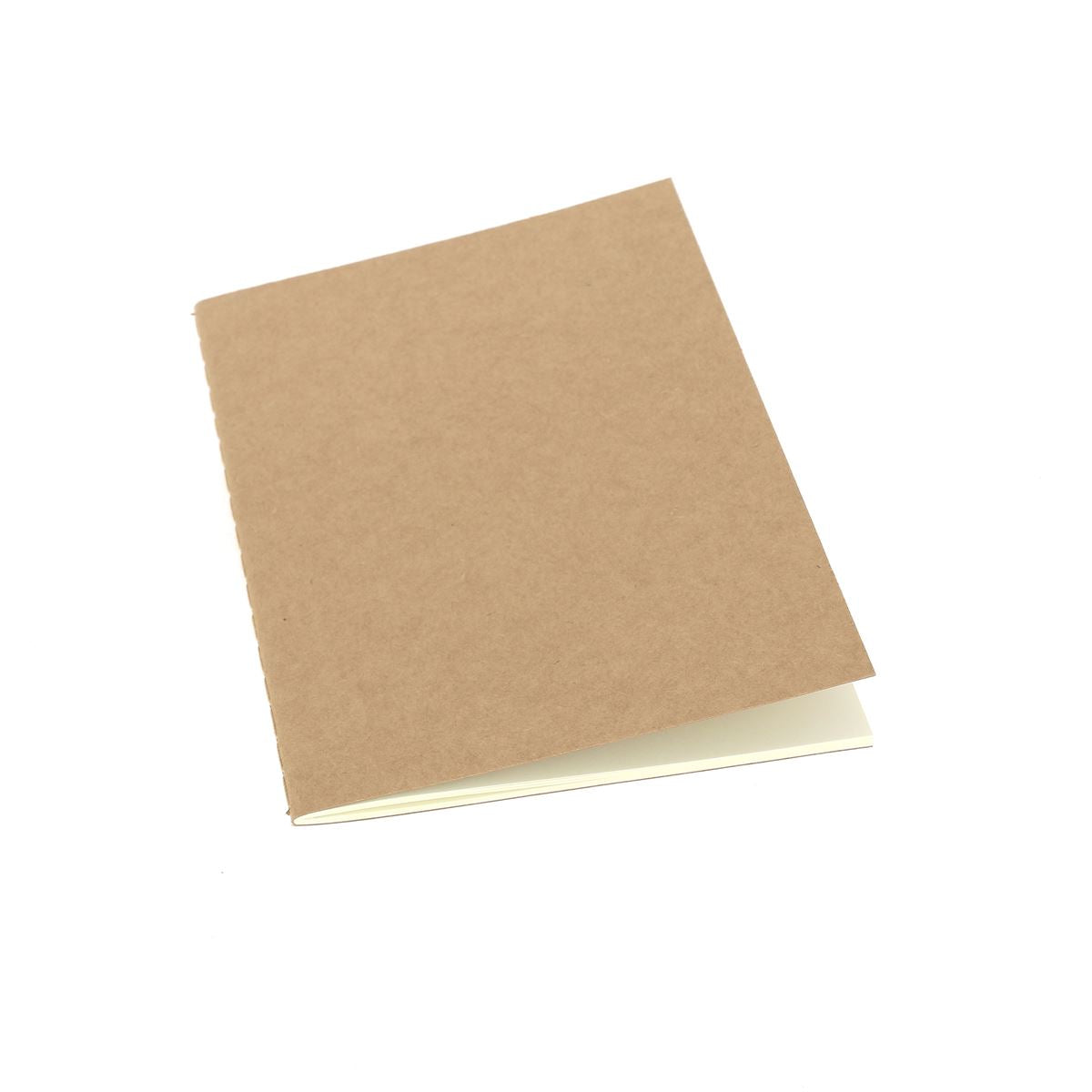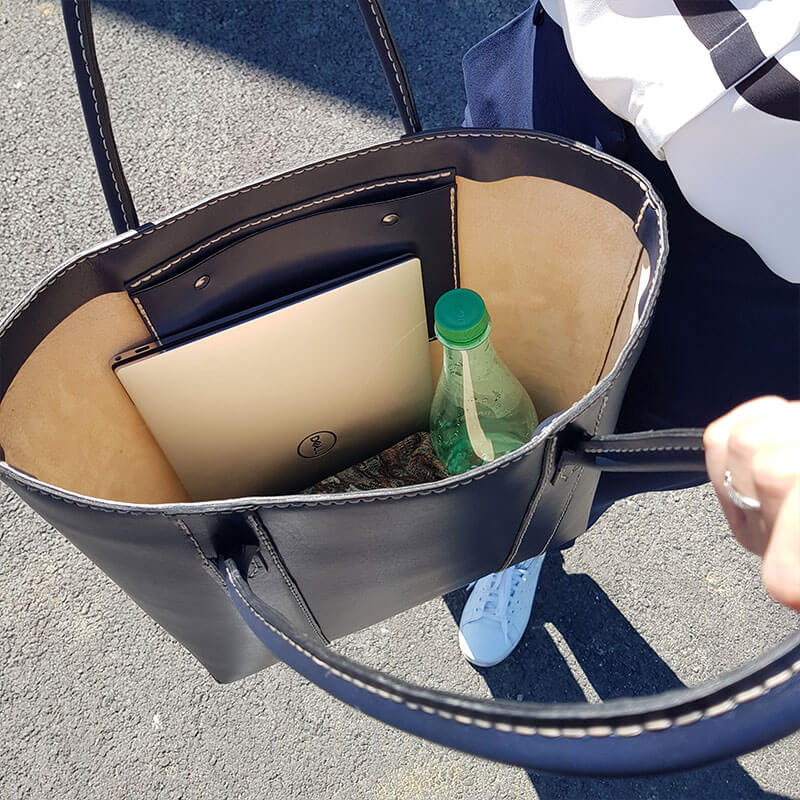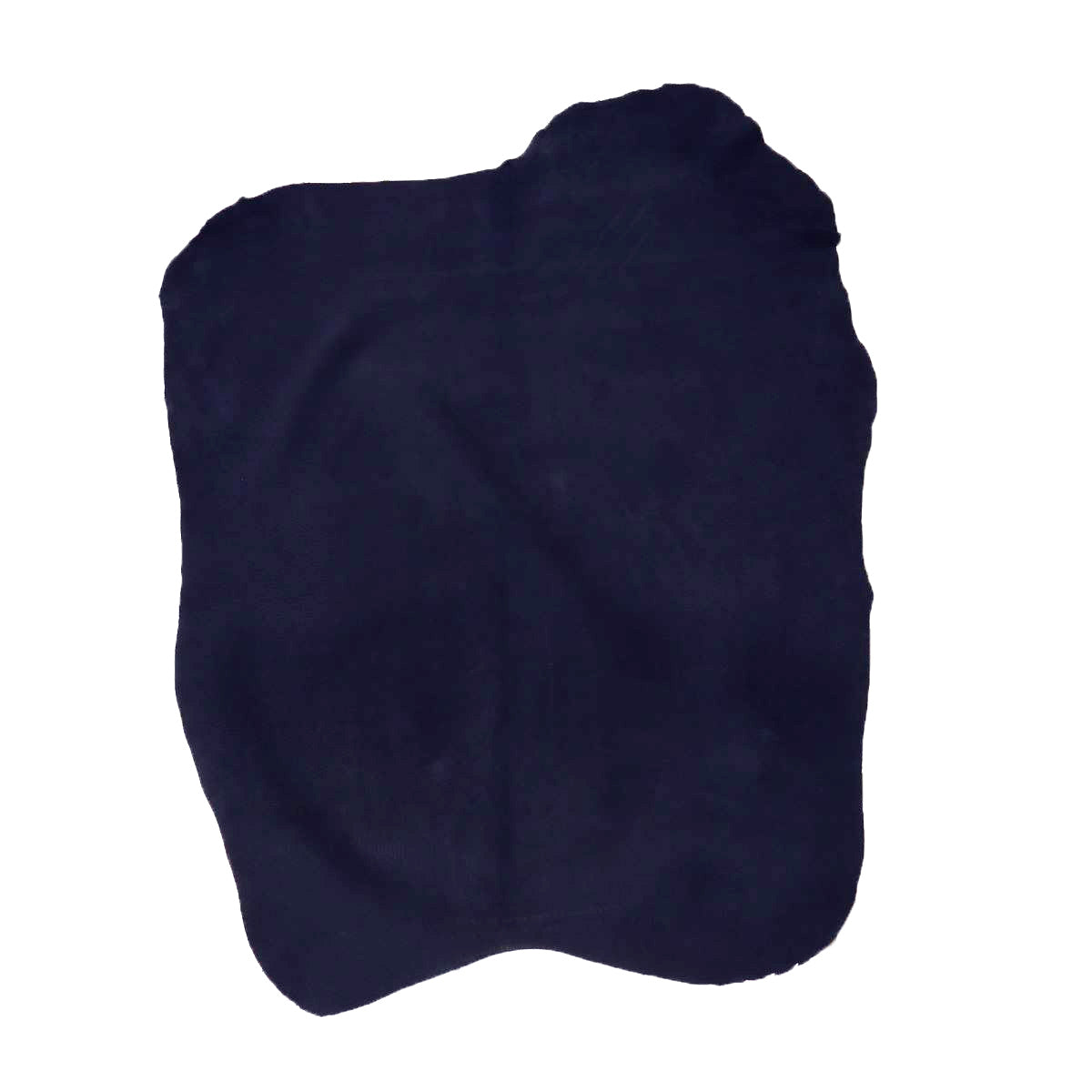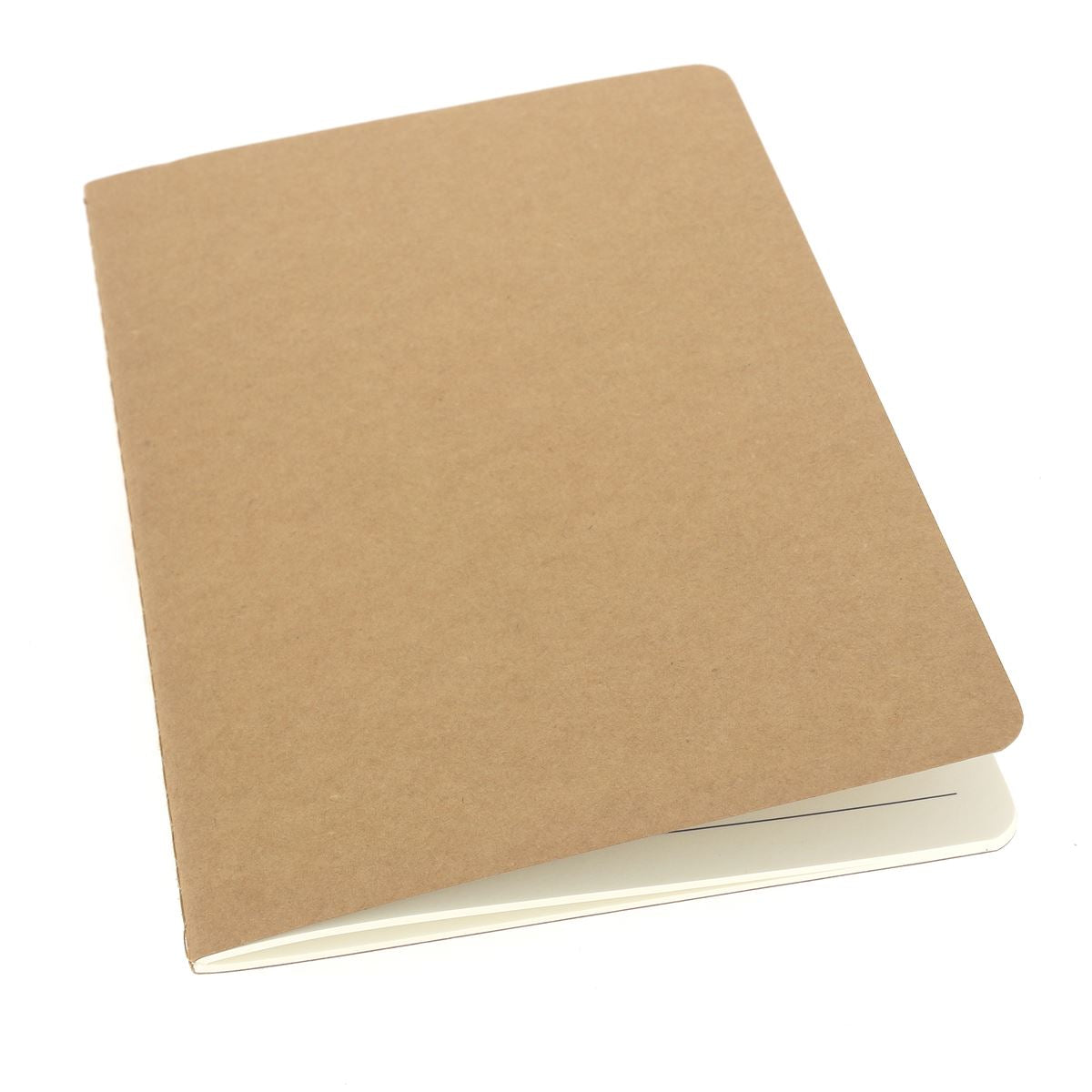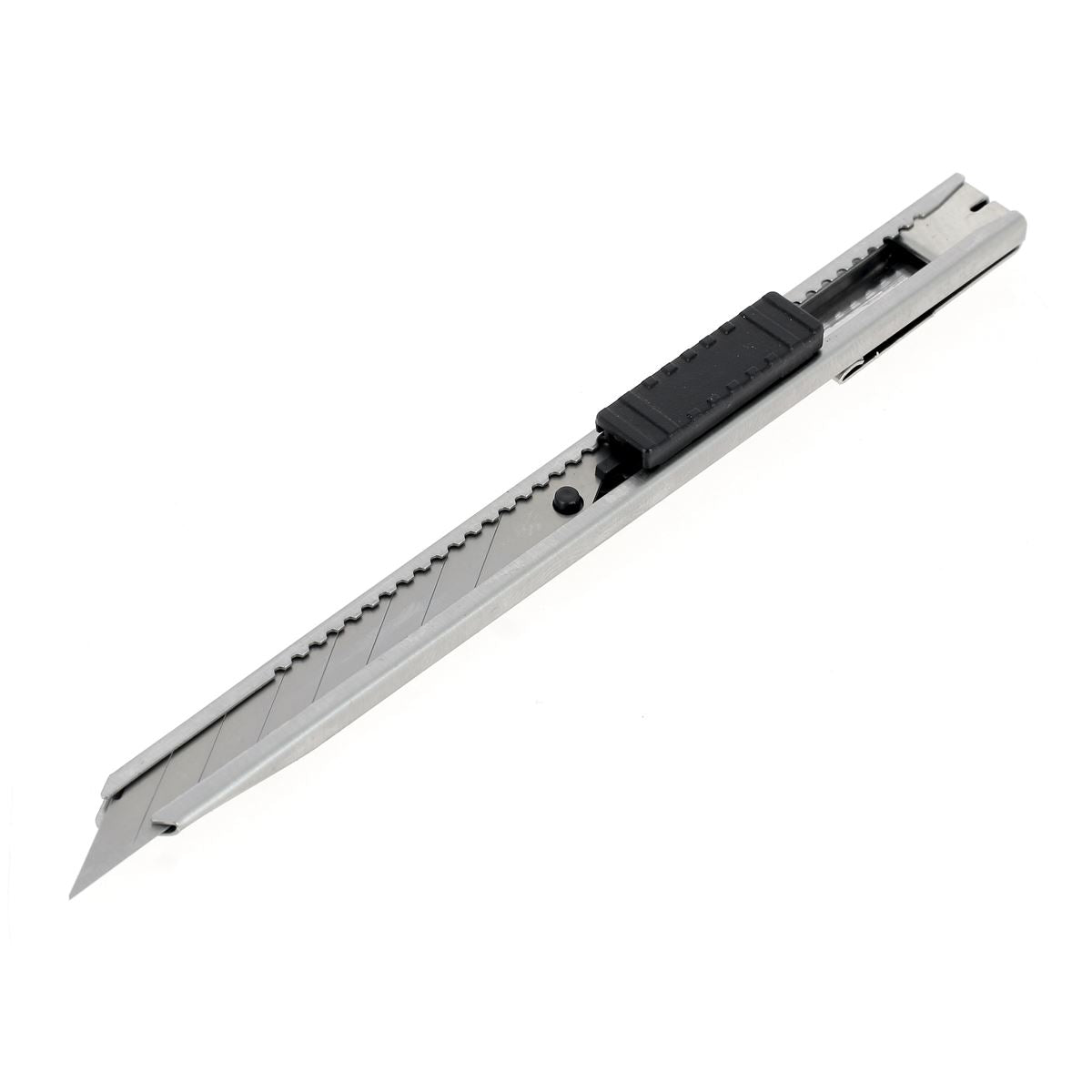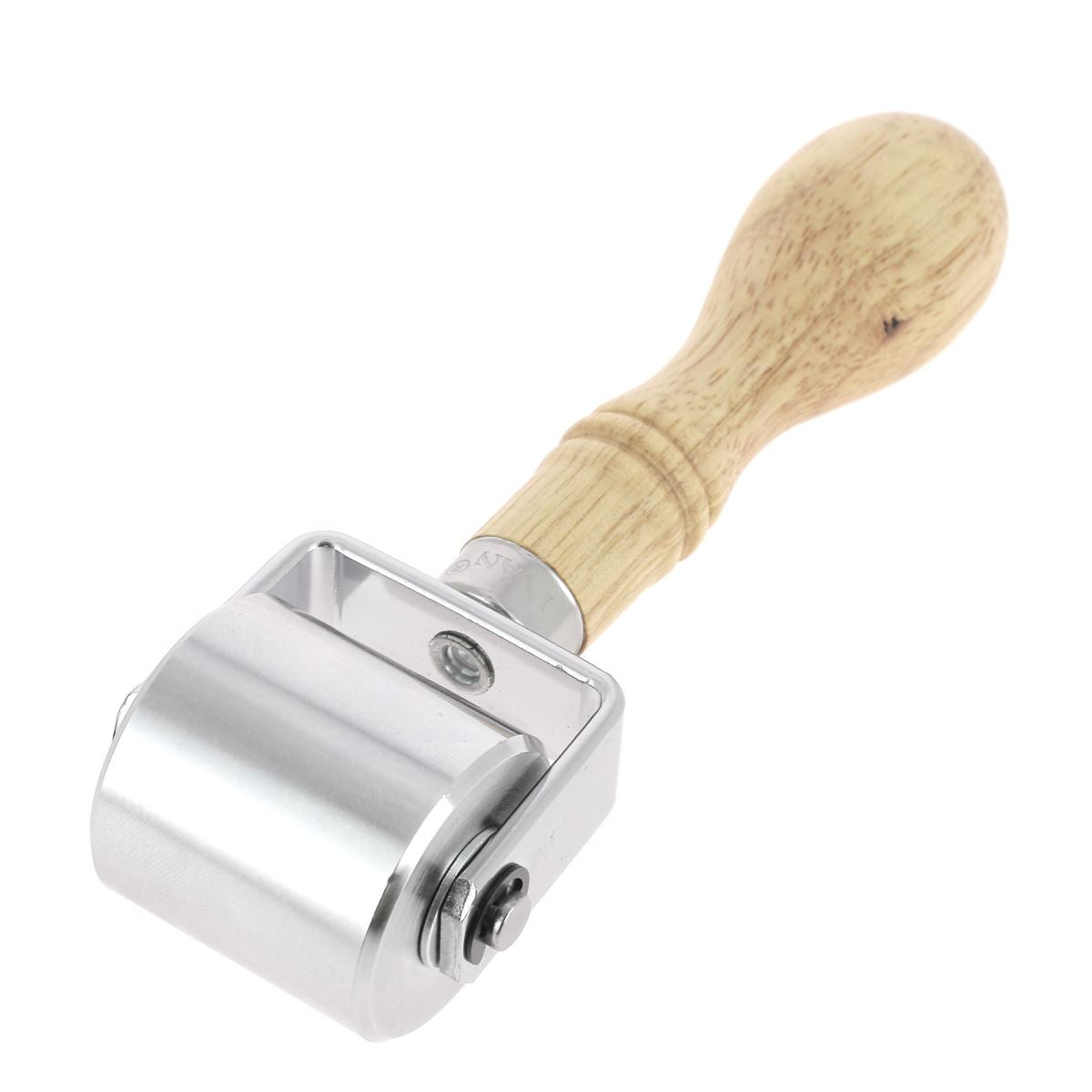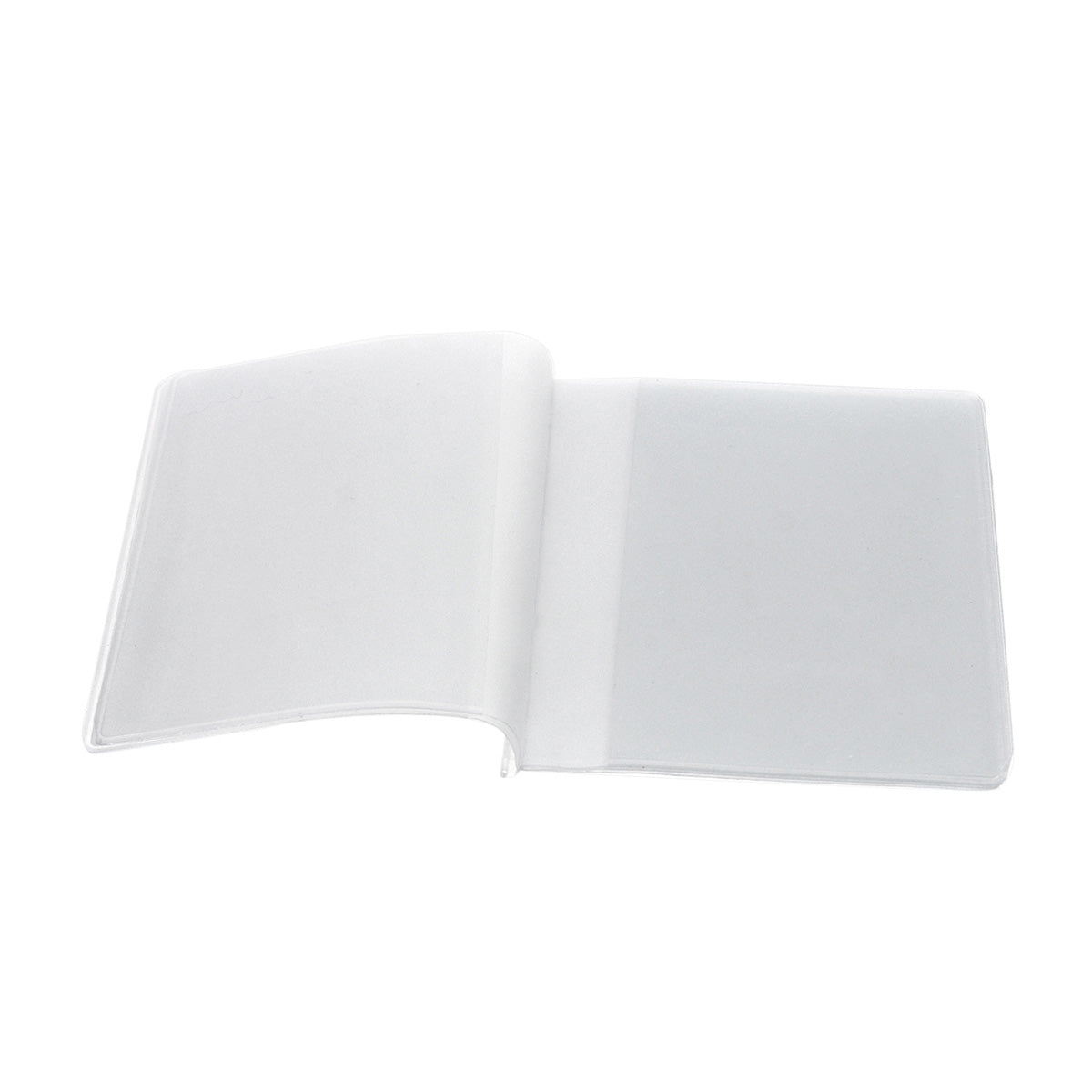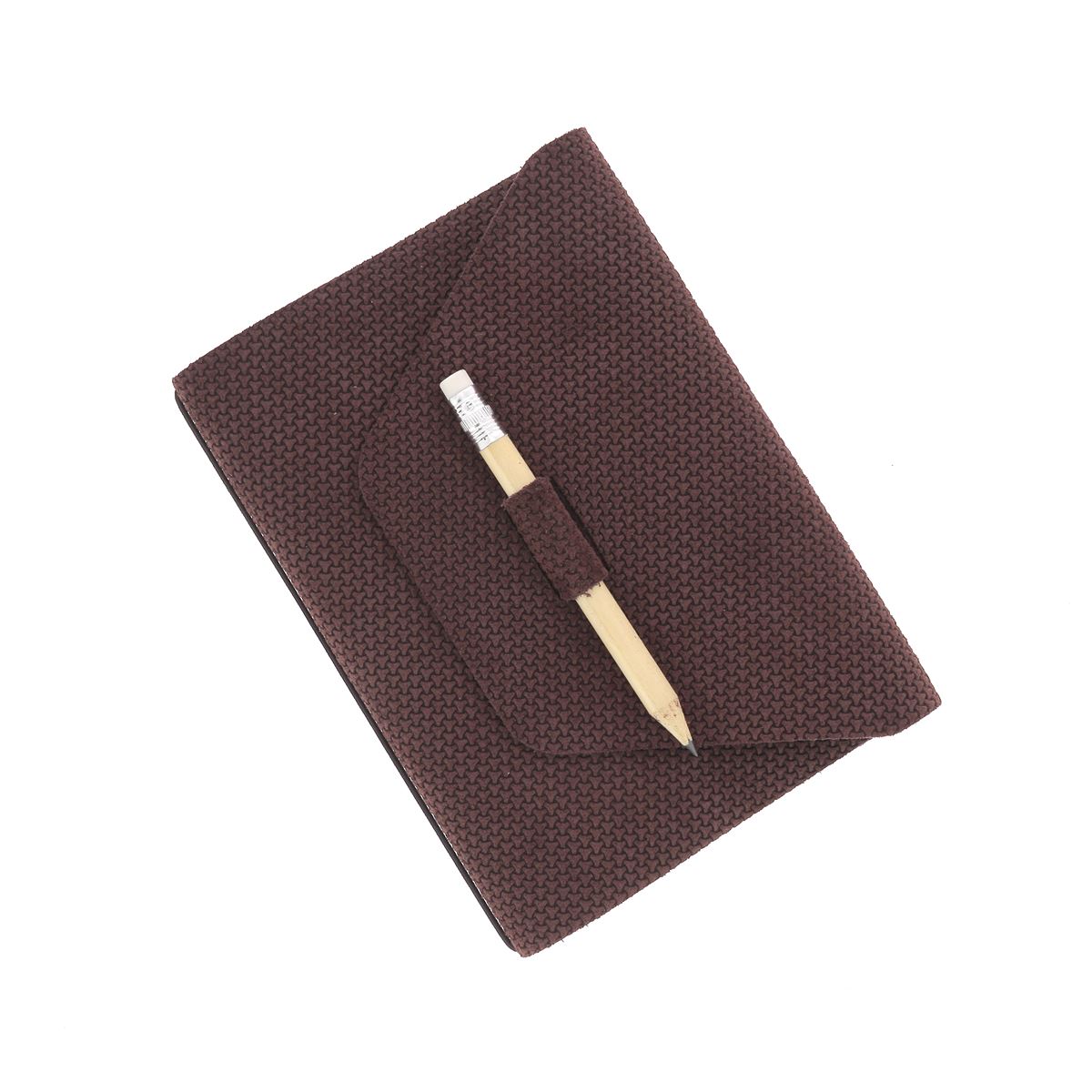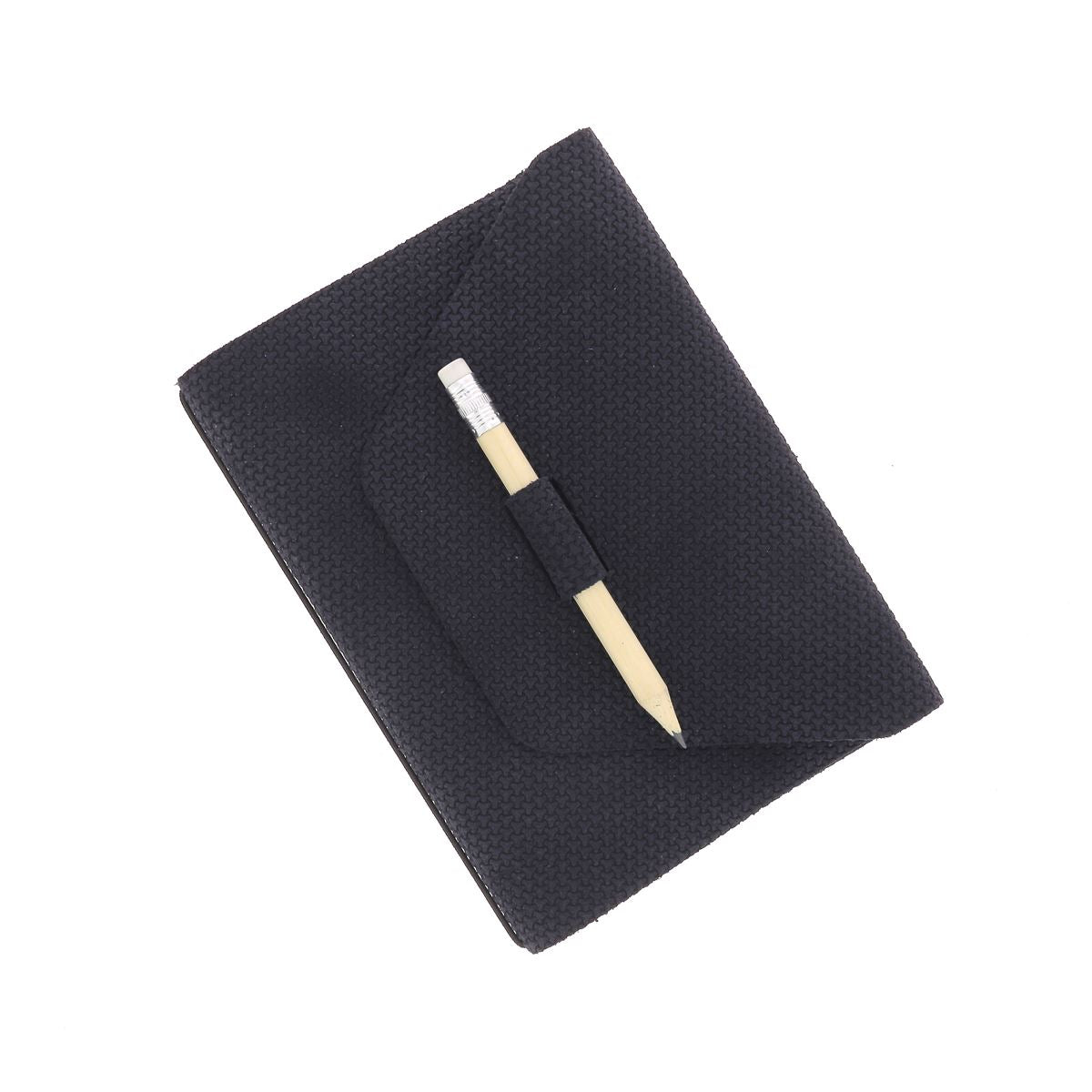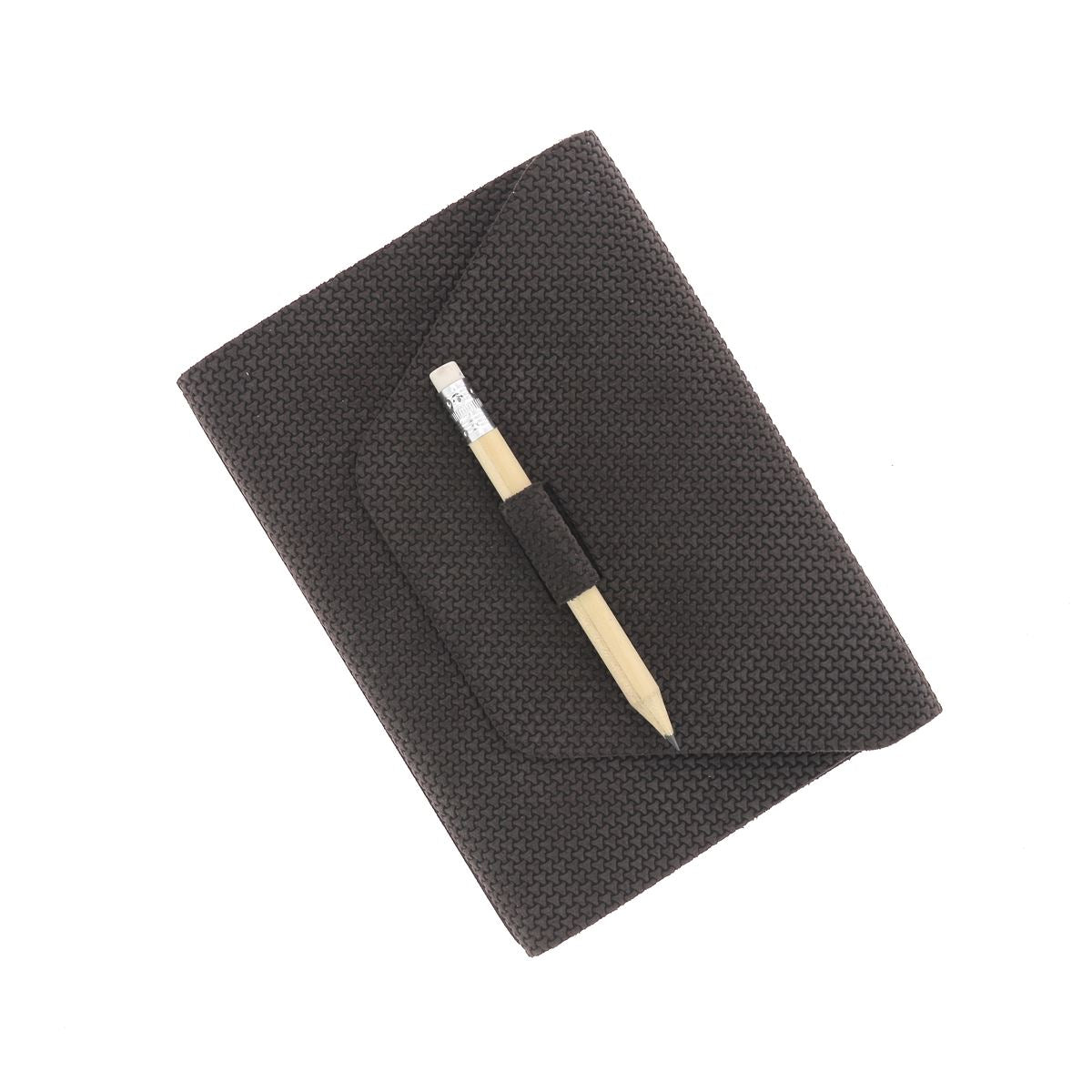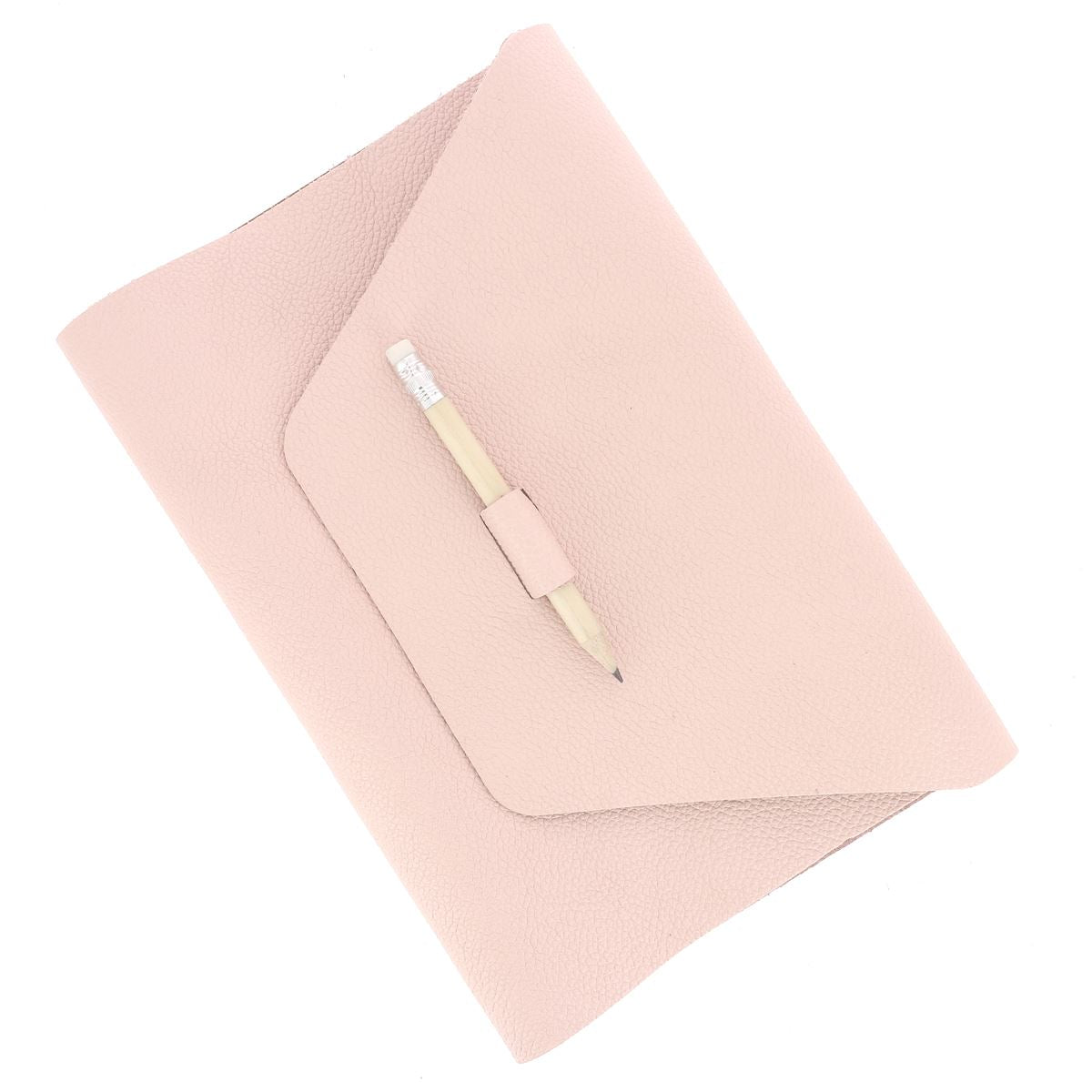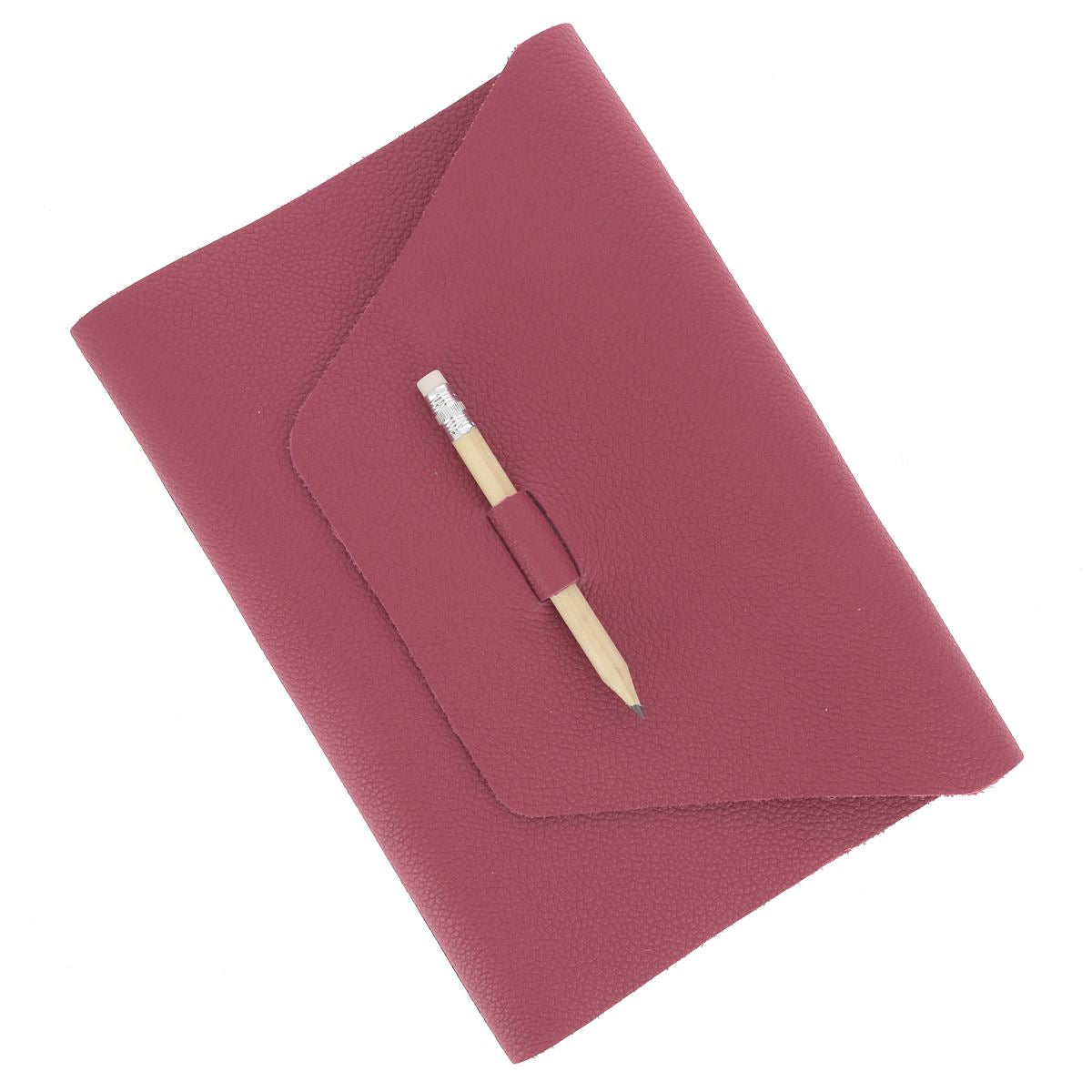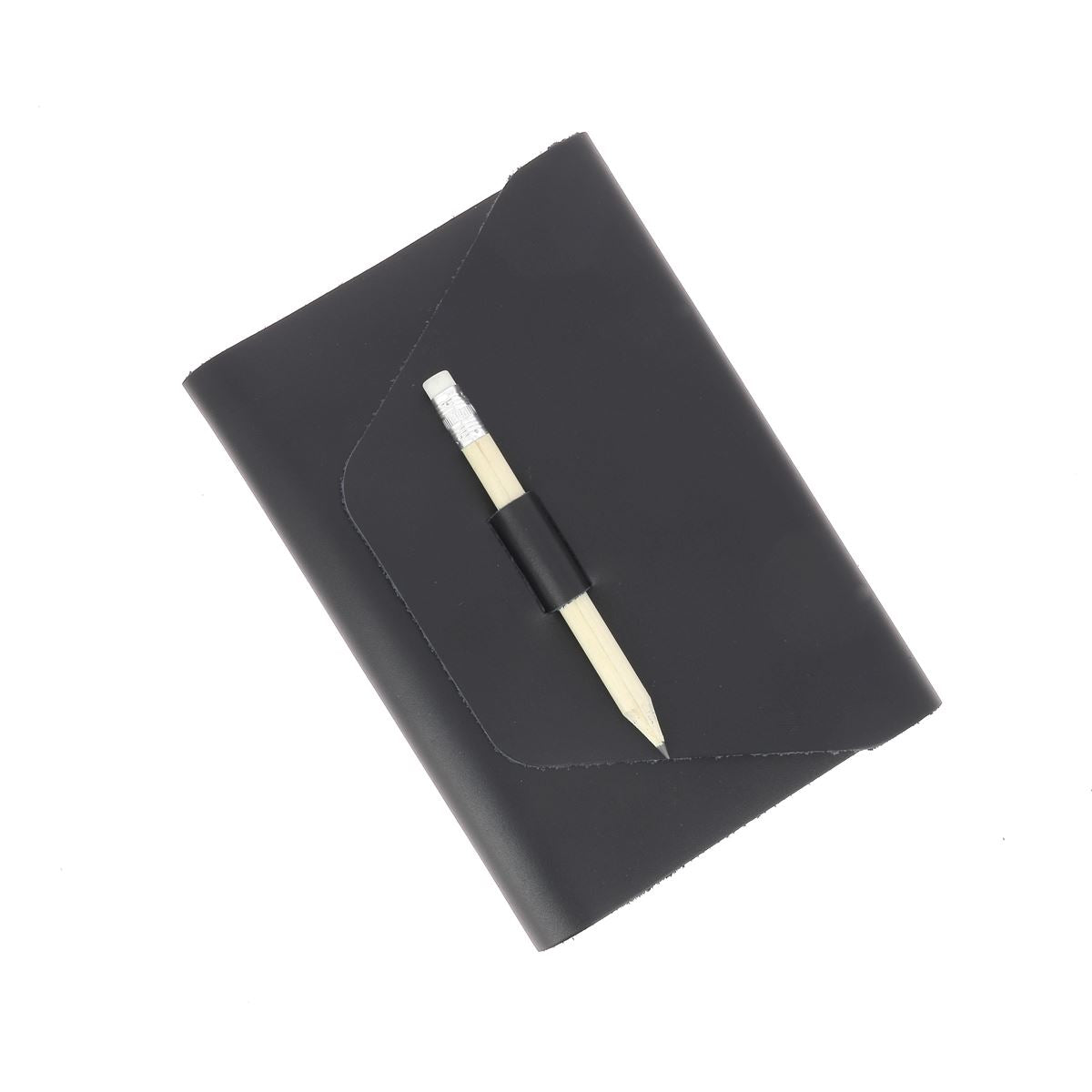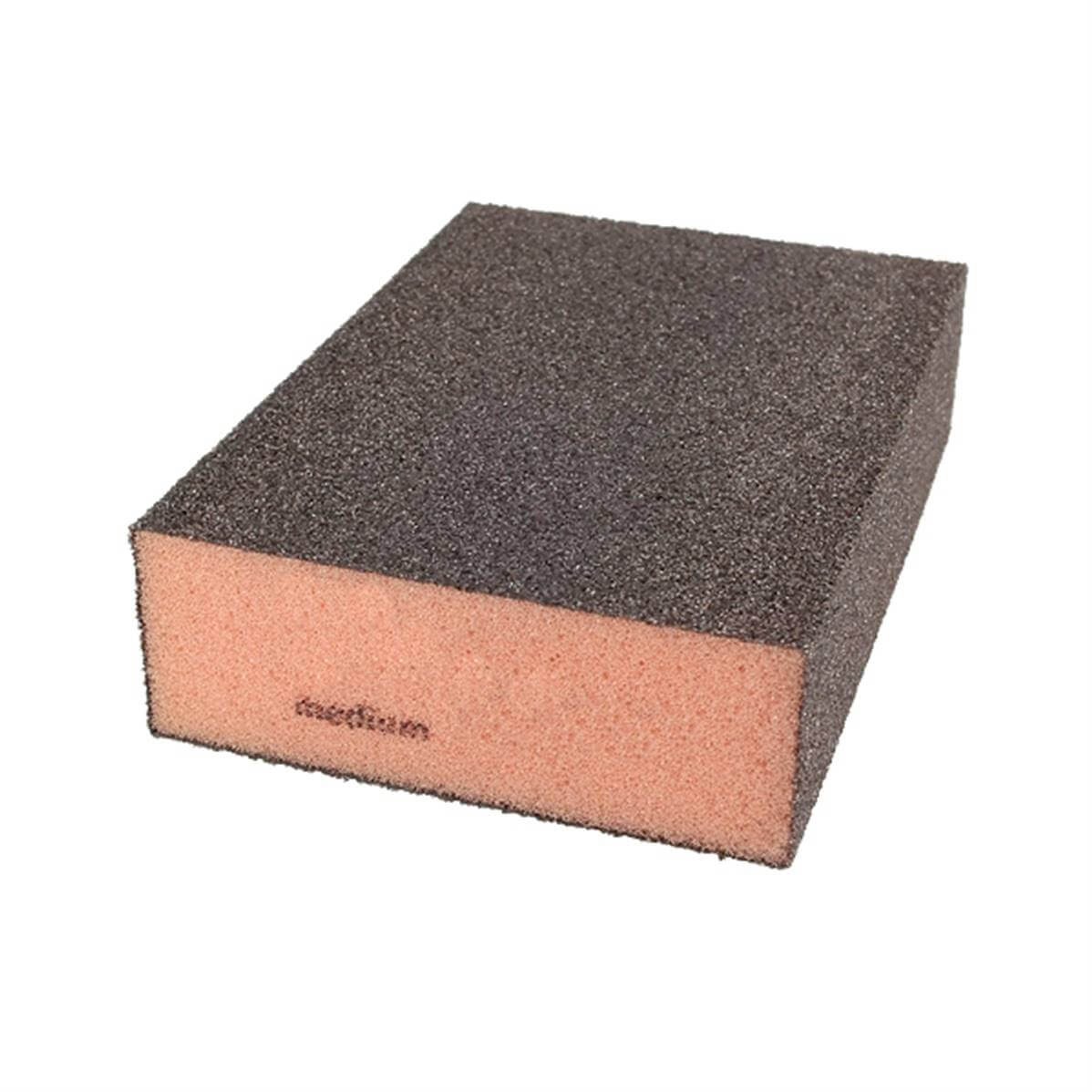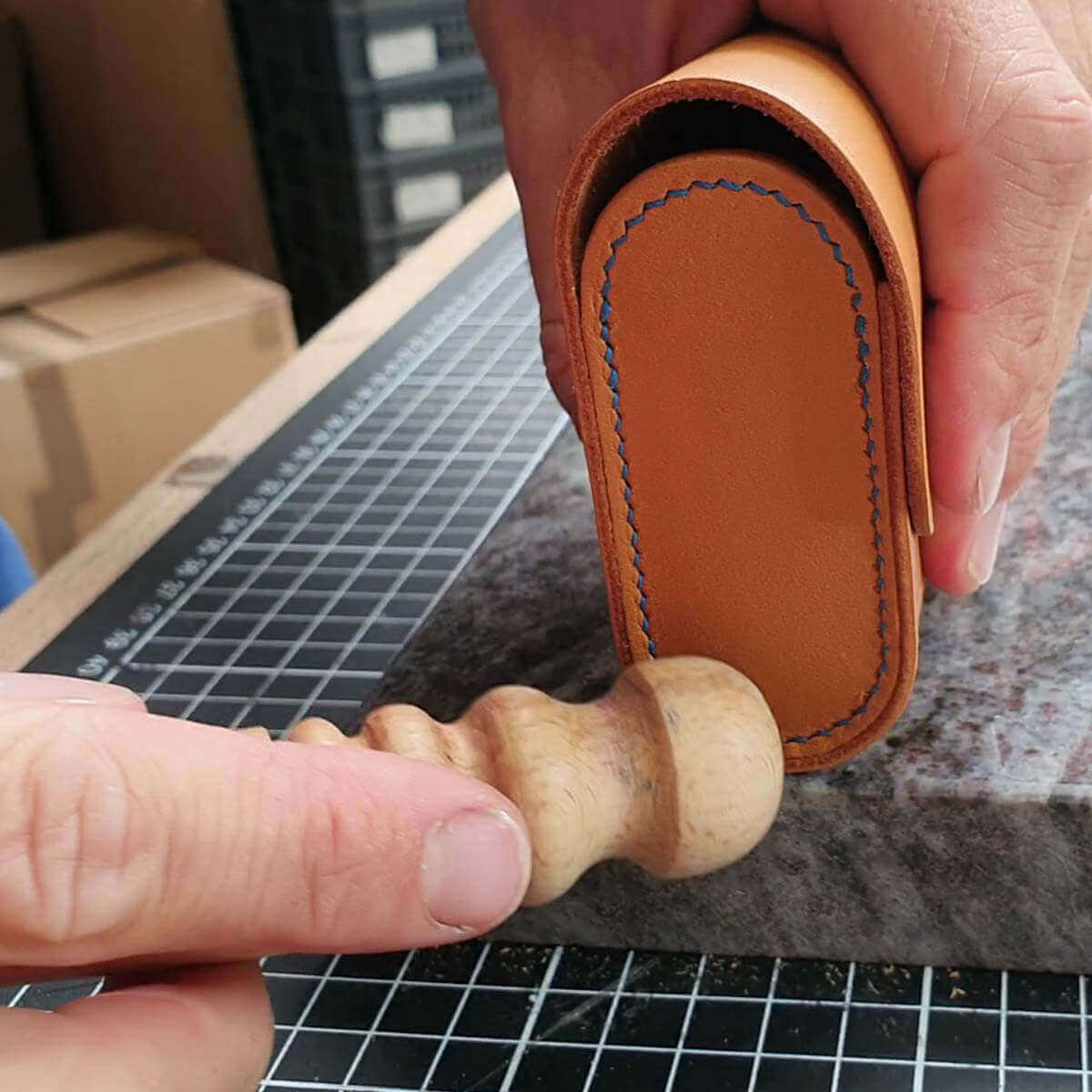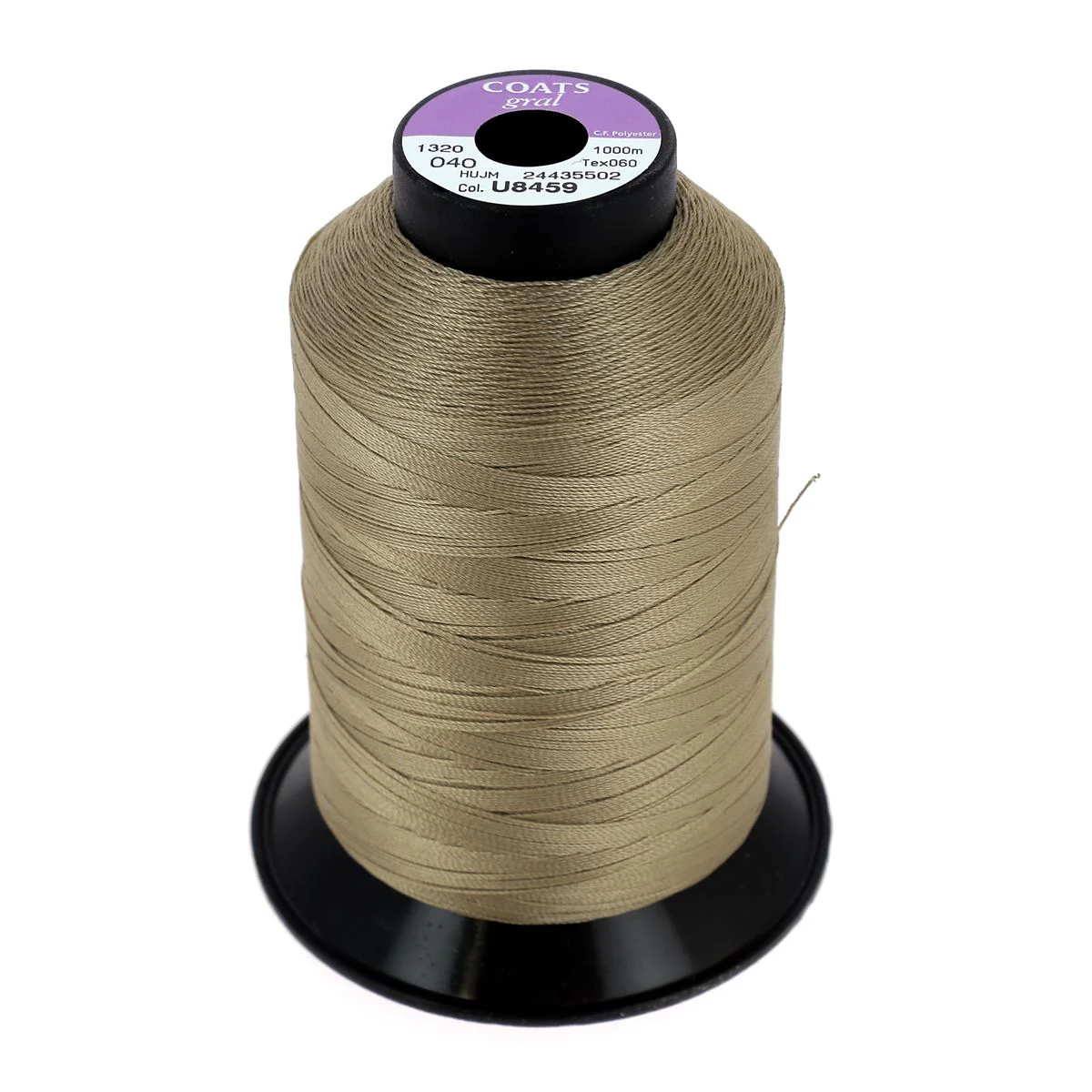VERSION NO. 1 - SIMPLE AND ELEGANT SEAMLESS
SUPPLIES IN DETAIL:
To complete this tutorial, you will need:
- 1 piece of fairly firm leather, approximately 1.4 mm thick
Estimated size: a piece of 20 x 30 cm for an A6 notebook, a piece of 30 x 40 cm for an A5 notebook. One piece of leather for an A4 notebook (approximately 0.40 m2) . - 1 piece of VELVET suede pigskin split leather (approximately 0.30 m2) .
- 1.5m of elastic cord - Diameter 1.5mm
- 1 leather loop clip
- Neoprene glue
OPTIONAL: Tokonole leather finishing gum OR edge finishing
And the following equipment:
- 1 cutter
- 1 corner template
- 1 pressure roller
- 1 round cookie cutter with a diameter of 2 mm and 3 mm
Little extras
Using the 4 elastic bands inside, you can slip in several notebooks, a passport, or even add our transparent card holder (available on our website - Ref. ) ! You can also personalize your leather with an imprint or add a piece of tricolor ribbon.

Video
1. Patronage
Calculating dimensions : ideally, add at least 1 cm for height (0.5 cm at the top and bottom) and add 2x the width and 2x the thickness + 7 cm. We recommend testing before cutting.
For an A6 format:
Our notebook measures 10.5 x 14.8 cm and is 1 cm thick.
For the height: add 1 cm margin (i.e. 15.8 cm total height).
For the width: 30 cm will be needed ( 10.5 + 10.5 + 1 + 1 + 7 = 30 cm ). This 30 cm includes the inner return (small flap) of approximately 6 cm.
Our cutout measures 15.8 cm x 30 cm. This version fits into a piece of leather measuring 20 x 30 cm.
SMALL LEATHER TAB (on the front of the notebook).
There is also a second piece measuring 9 x 2 cm to be cut from the leather scraps.
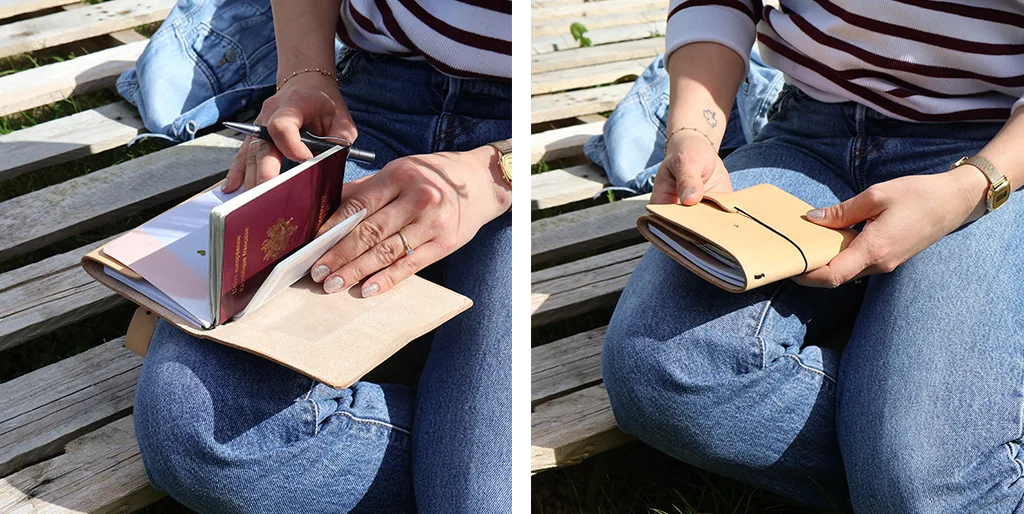
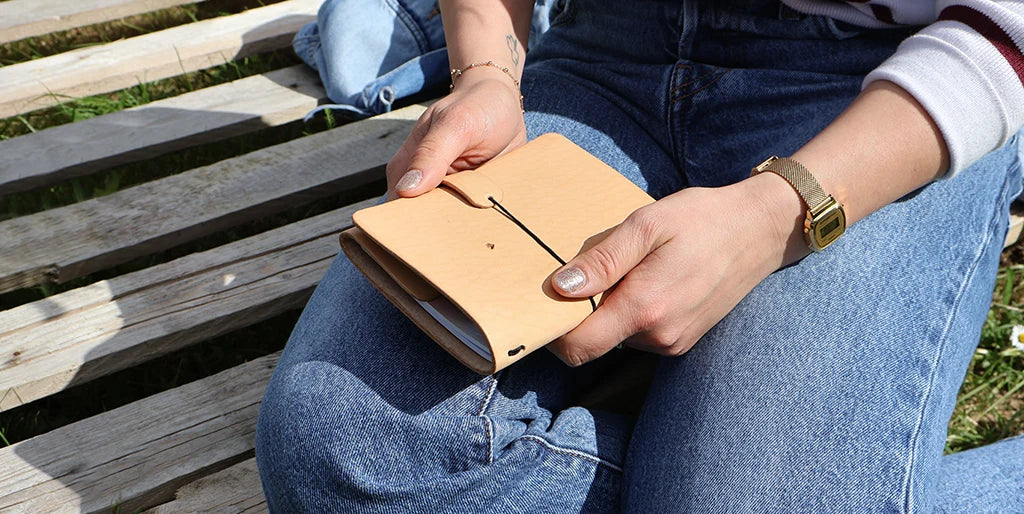
For an A5 format:
Our notebook measures 14.8 x 21 cm and is 1 cm thick.
For the height: add 1 cm margin (i.e. 22 cm total height).
For the width: 39 cm will be needed ( 14.8 + 14.8 + 1 + 1 + 7 = 39 cm ). This 39 cm includes the inner return (small flap) of approximately 6.5 cm.
Our cutout therefore measures 22 cm x 40 cm. This version fits into a piece of leather measuring 30 x 40 cm.
SMALL LEATHER TAB (on the front of the notebook).
There is also a second piece measuring 9 x 2 cm to be cut from the leather scraps.
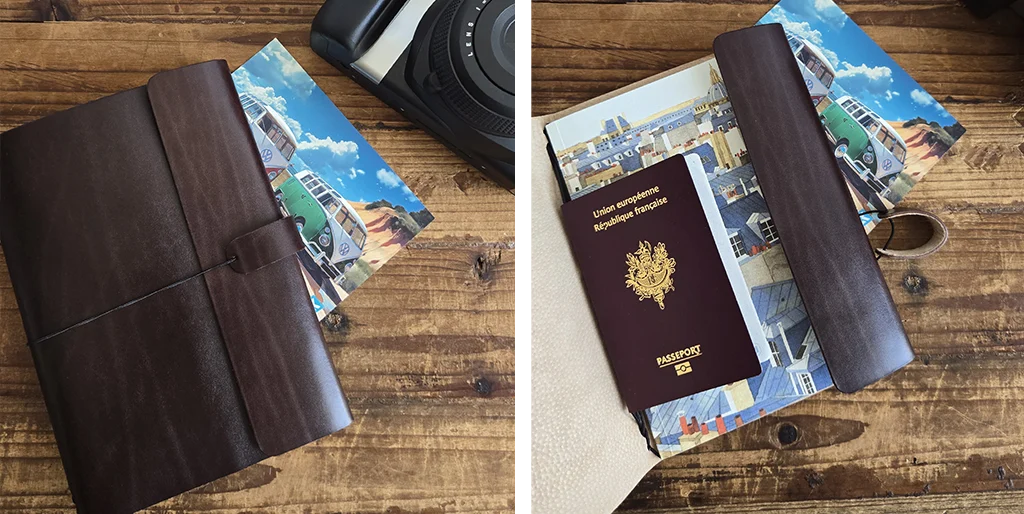
ASIDE
Do you have an A6 or A5 notebook and want a notebook cover that's easy to use and affordable? Fall for one of our leather cutouts!
For an A4 format:
Our notebook measures 21 x 29.7 cm and is 1 cm thick.
For the height: add 1 cm margin (i.e. 31 cm total height).
For the width: 51 cm will be needed ( 21 + 21 + 1 + 1 + 7 = 51 cm ). This 51 cm includes the inner return (small flap) of approximately 6.5 cm.
Our cutout therefore measures 31 cm x 51 cm. This version fits into a piece of leather approximately 0.40 m2.
SMALL LEATHER TAB (on the front of the notebook).
There is also a second piece measuring 9 x 2 cm to be cut from the leather scraps.
For the health record book and the paperback book we preferred version No. 2 with stitching (a little further down in the blog post) but you can very well make a health record book cover or a book cover without stitching (version No. 1).
- For a paperback book cover (11x18 cm and approximately 350 pages - i.e. 2 cm thick) you will need a piece of approximately 19 x 35 cm and a tab of 2 x 13 cm.
- For a health record cover (15 x 21 cm and approximately 104 pages - i.e. 0.7 mm thick) you will need a piece of approximately 22 x 40 cm and a tab of 2 x 9 cm.
2. Cut the leather
Using a craft knife (and a new blade), cut out the main rectangle according to the calculated dimensions. Then, also cut out the tab from the remaining scraps.

3. OPTION: nourish the leather
If you choose natural vegetable-tanned leather, like the A6 notebook we're using, we recommend conditioning it with neatsfoot oil. The oil will soften the leather, provide light protection, and give it a slightly darker tint.
If your leather has a mineral tan or has already received a finish, we invite you to skip this step.
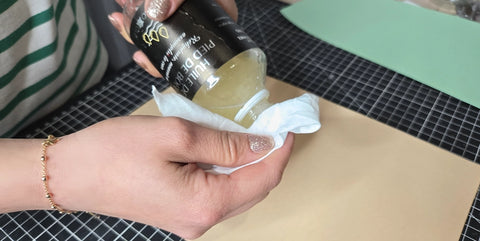 |
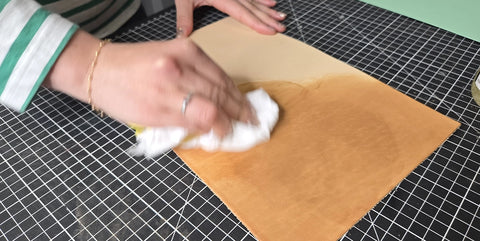 |
4. Line the leather with suede pigskin
Cut a piece slightly larger than the main piece from the suede pigskin. Apply contact adhesive to both the back of the suede and the back of the leather piece. Wait a few moments for the adhesive to soak in, then glue them together.
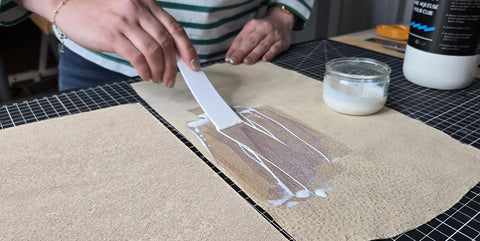 |
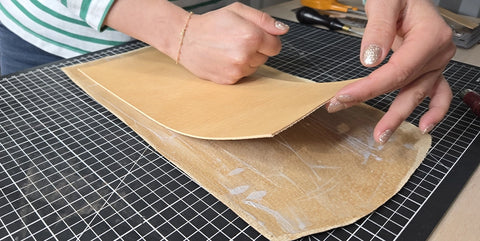 |
Flatten the glued material using a pressure roller.
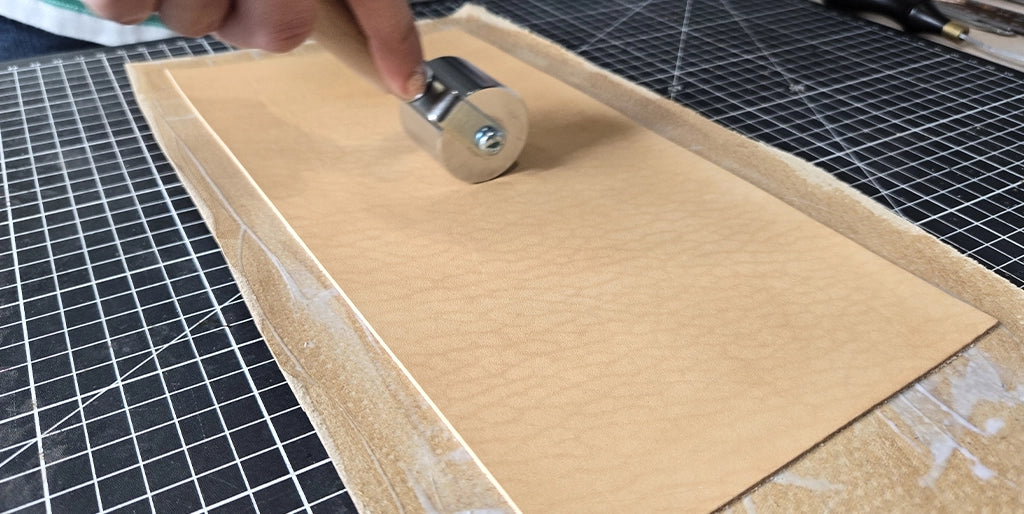
5. Overcut the leather
Trim the excess suede pigskin: cut edge to edge using a rotary cutter.
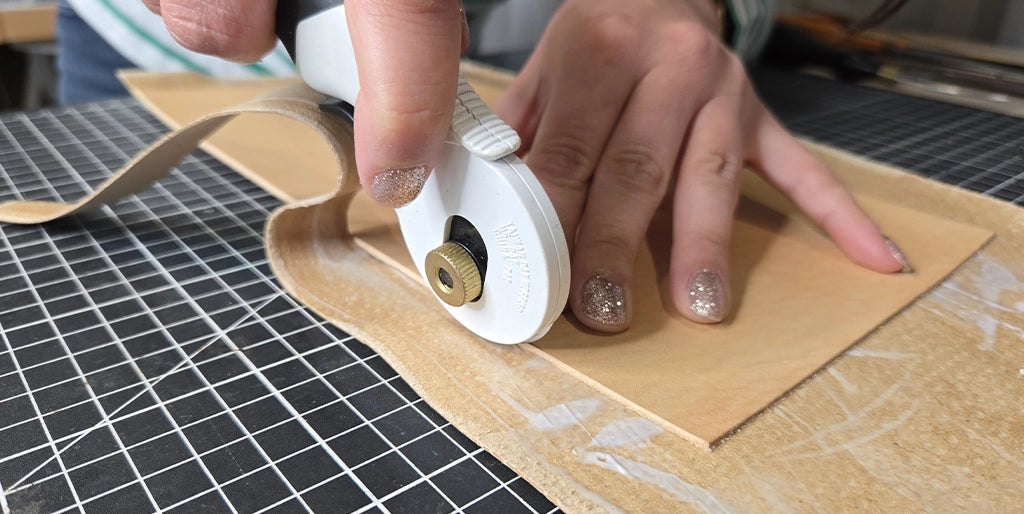
6. Round off the corners
Using a template (paper or plexiglass) , round the corners of the main piece and the tab. Here, we made 8 mm corners.
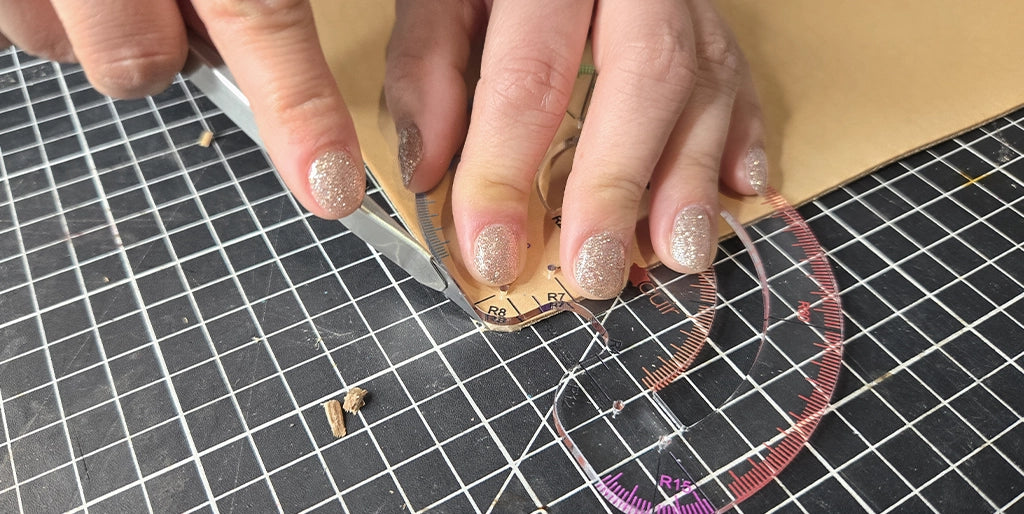
7. OPTION: working the slices
As an option (for a more finished result) it is possible to work the edges of the leather.
For vegetable-tanned leather:
- Flatten the leather edges.
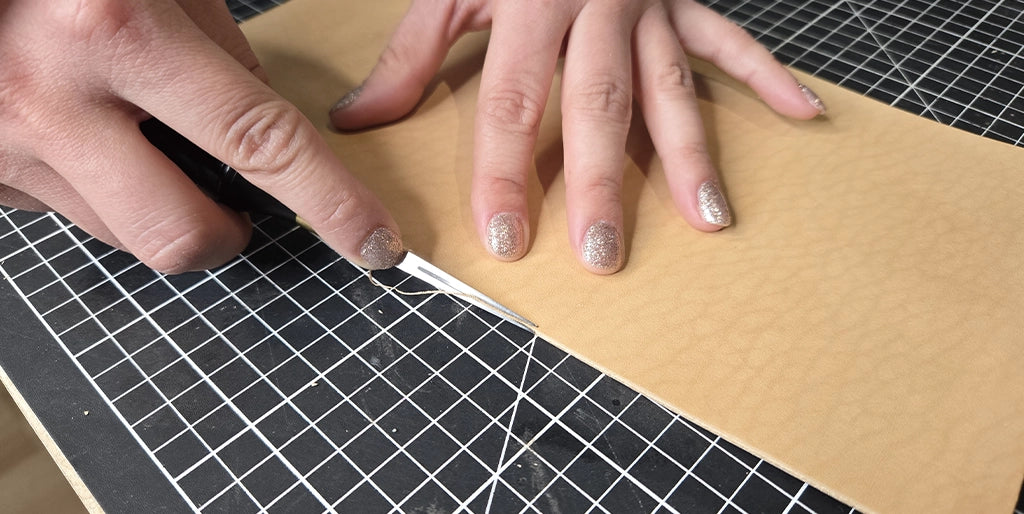
- Sand the edges with an abrasive sponge or a sanding block (always in the same direction) .
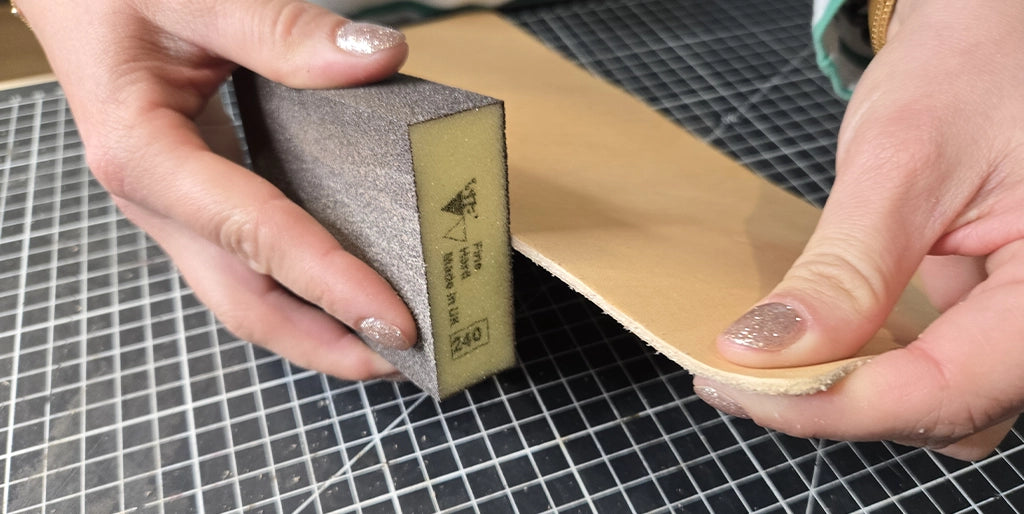
- Apply Tokonole (finishing eraser) to the edge and rub vigorously with a cotton cloth or smoother.
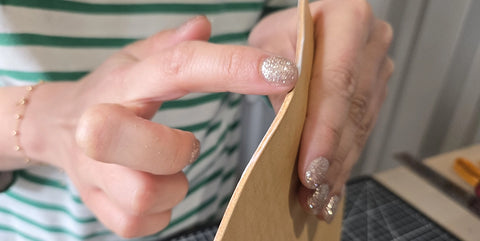 |
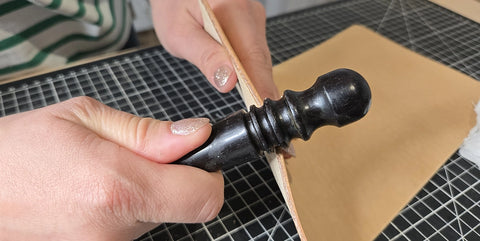 |
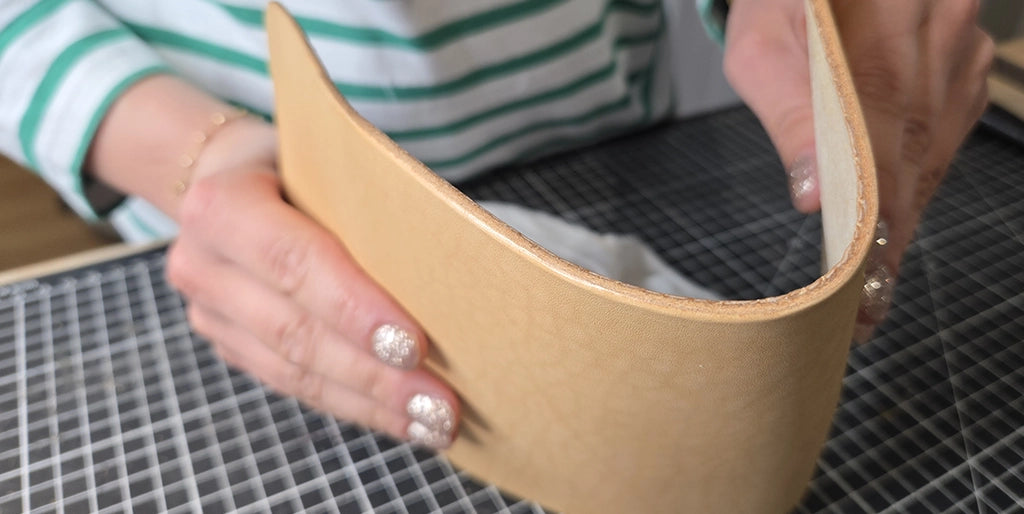
For mineral tanned leather: work the edges with an edge finish (paint).
8. Crease the folds
Take the notebook and place it in the piece of leather: leave approximately 5 mm of space all around the notebook. Score the folds where you want to close the notebook. Use a crease smoother if needed.
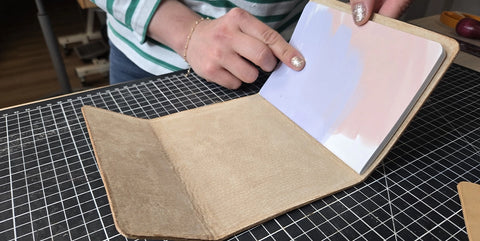 |
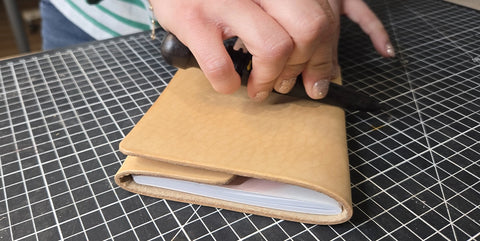 |
9. Attach the elastic band
Close the notebook cover and mark a dot in the center of the back of the notebook cover.
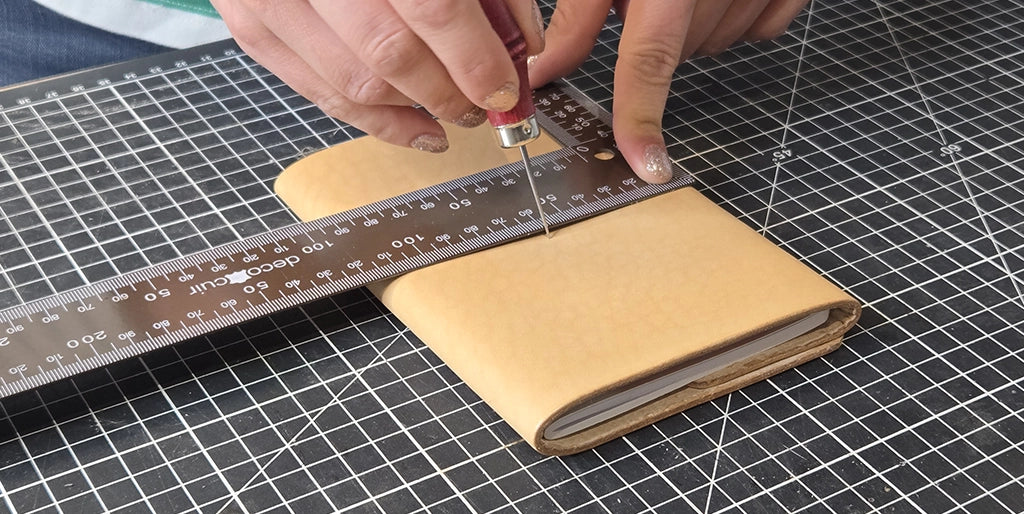
Make a 3 mm diameter hole at this location.

Mark the position of the staple prongs on each side of the Ø 3 mm hole.
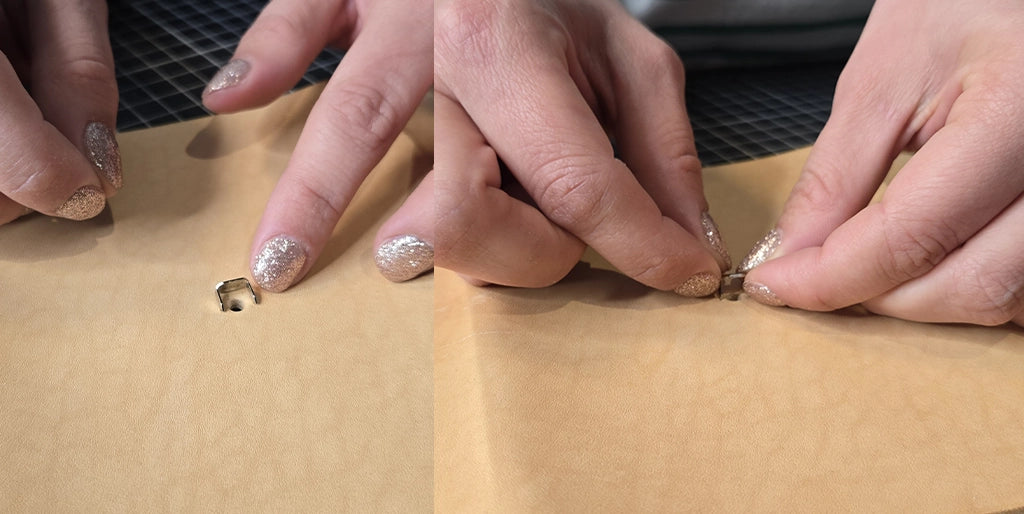
Then make 2/3 mm slits at the markings with a cutter.
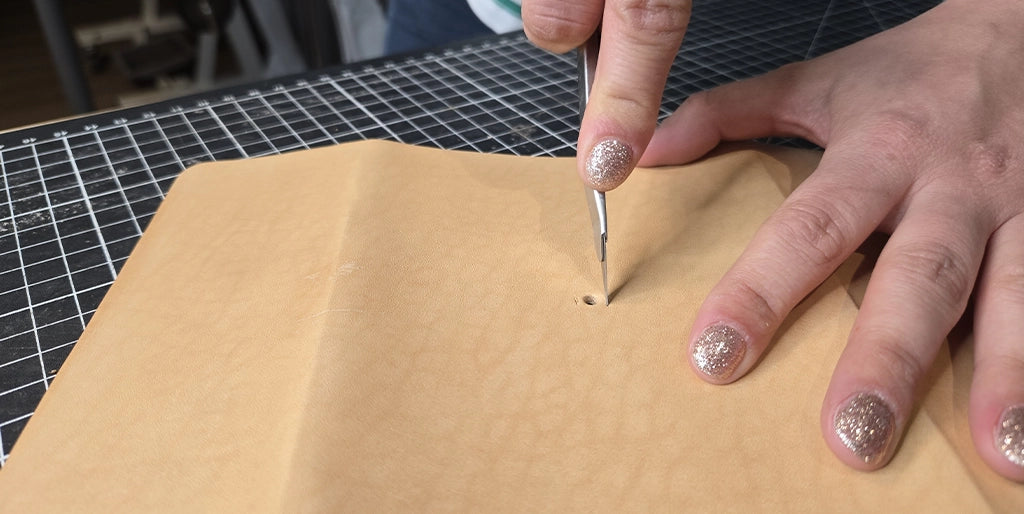
Take the tab and make a Ø 2 mm hole at each end of it.
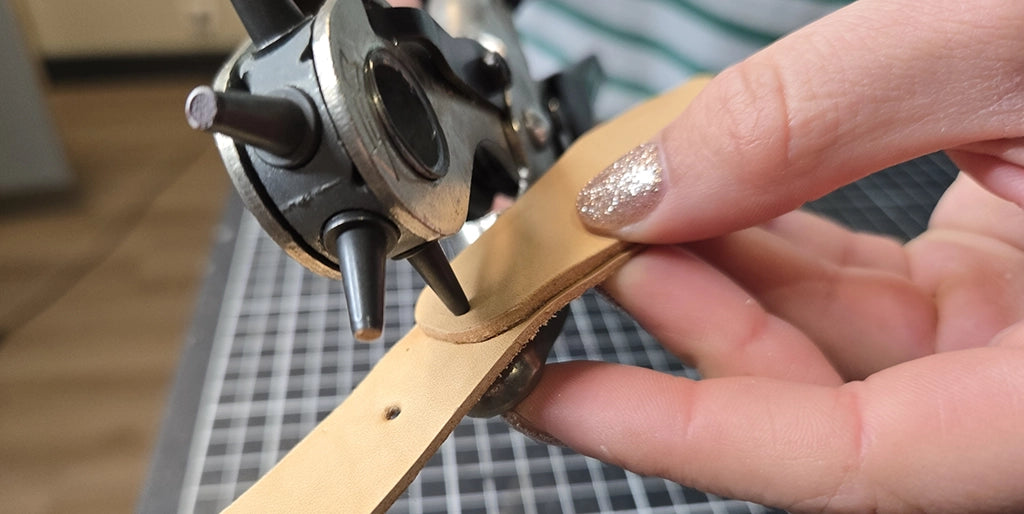
Take an elastic band of about 40 cm and pass it through the holes at the ends of the leather tab.
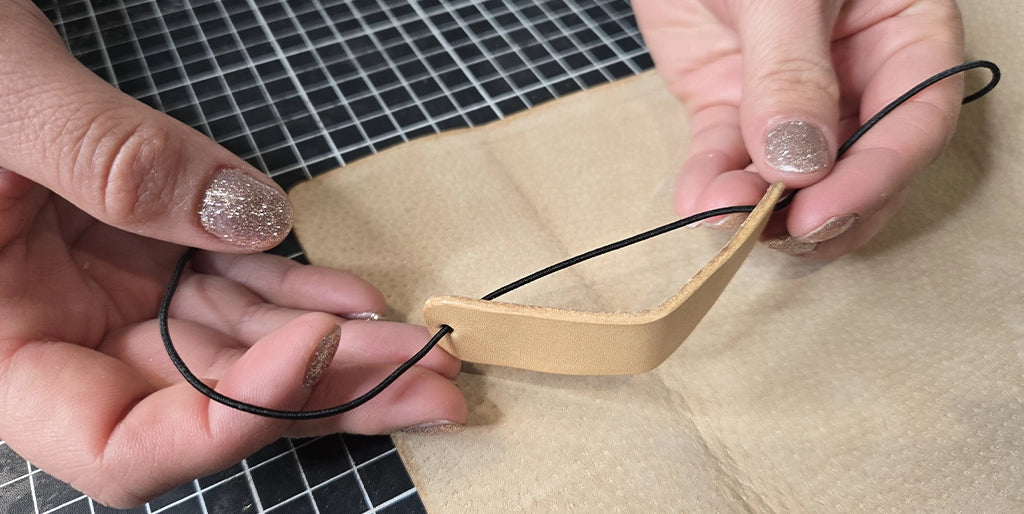
Fold the elastic in half and pass it through the hole, making sure that both ends end up inside the notebook.
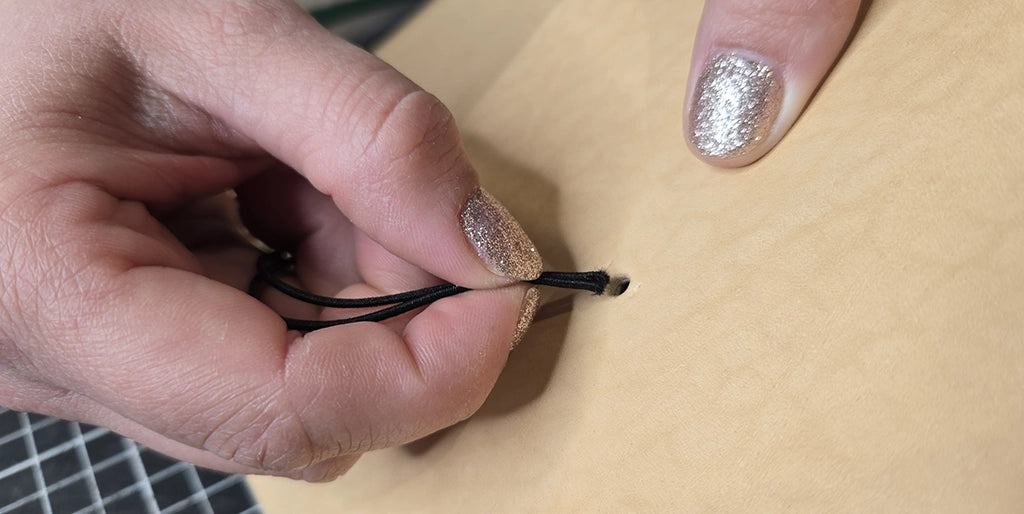
Tie a loose knot and check the size by closing the notebook. Adjust the elastic size and tie a tight knot.
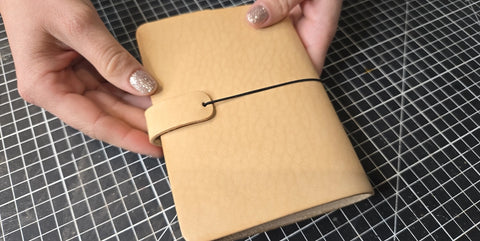 |
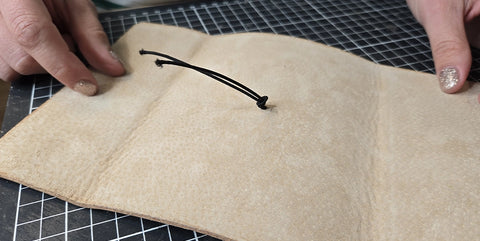 |
Insert the staple into the slots made beforehand, then fold down the tabs of the staple, taking care to tuck the elastic underneath.
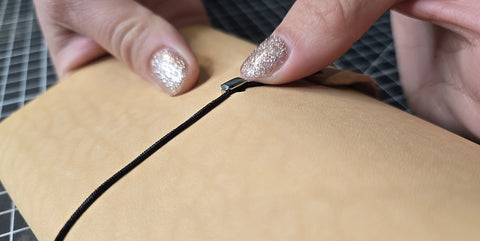 |
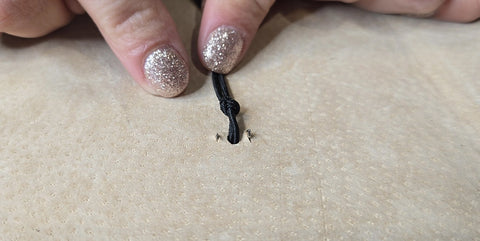 |
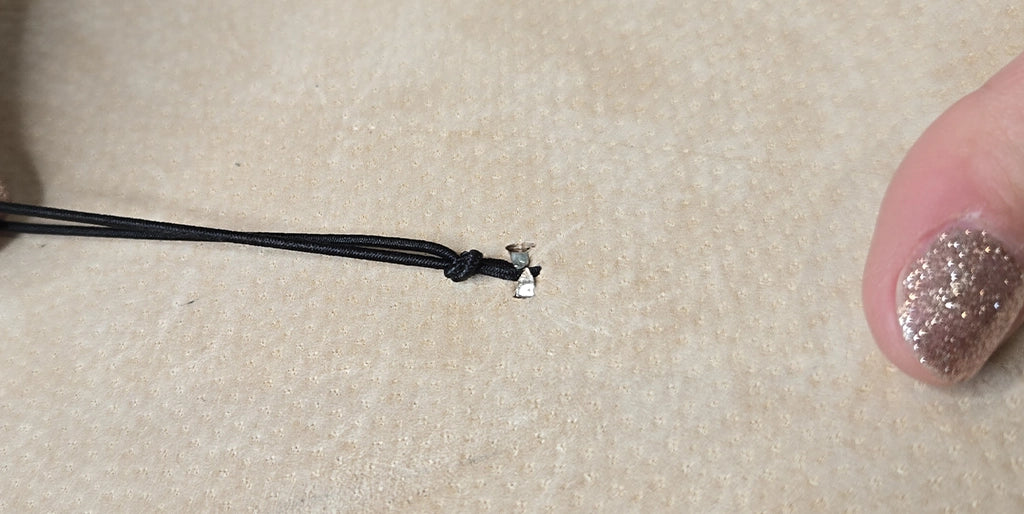
Cut off the excess elastic.

10. Put the middle elastic bands in place
On the spine of the notebook: mark a first dot 1 cm from the edge, then a second 2 cm from the edge. Do the same for the bottom of the notebook: a first dot at 1 cm and a second at 2 cm.
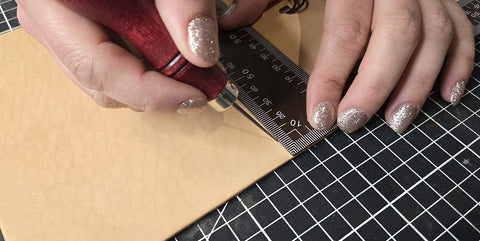 |
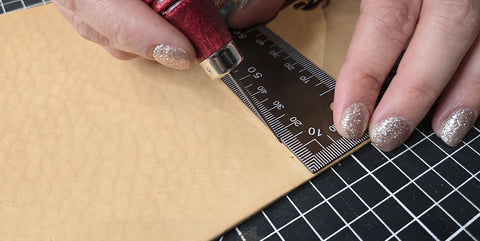 |
Drill Ø 3 mm holes at these locations.
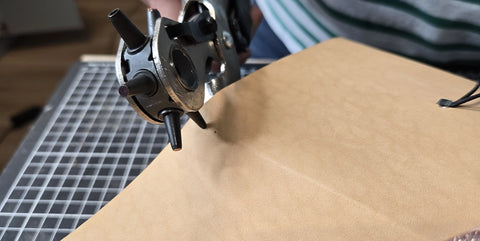 |
 |
Take 40 cm of elastic. Pass the elastic through the first hole (from the inside), then through the second hole. Go to the third hole and out through the last hole. Bring the two ends of the elastic together and tie a double knot.
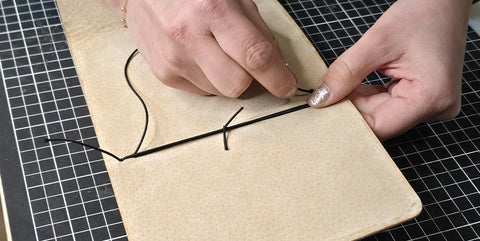 |
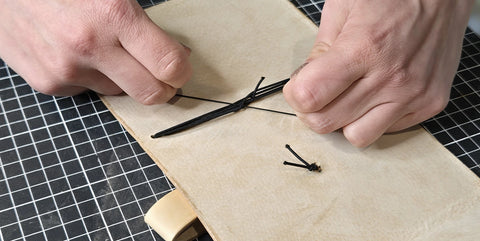 |
Add several elastic threads depending on the number of items to be fixed in the notebook (here we used 2 elastics of 40 cm) .
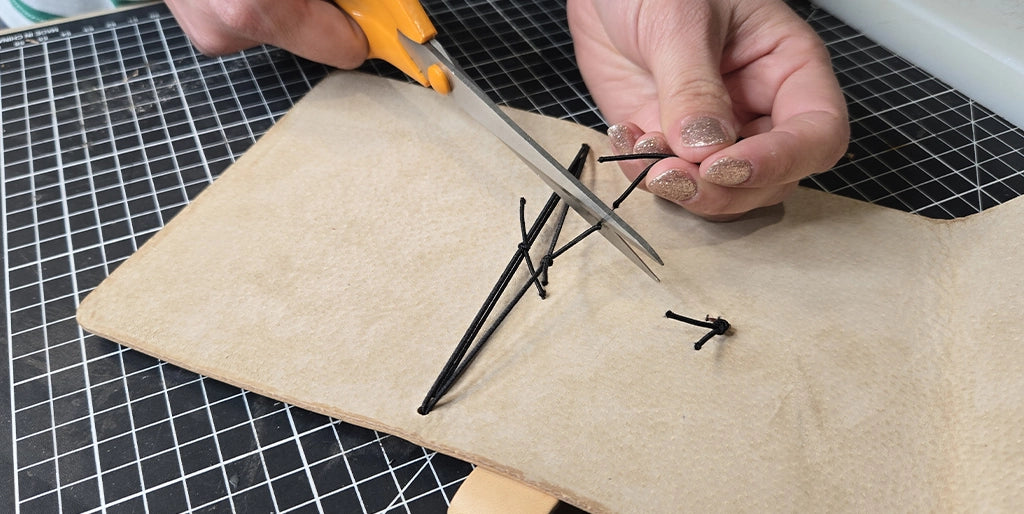
11. OPTION: customization
Please note that cold stamping is only possible on vegetable-tanned leathers.
Personalize the notebook with a marking either on the tab or directly on the leather.
SEE THE LEATHER MARKING GUIDE >
Here, we marked a small heart with a stamp (after evenly moistening the leather) .
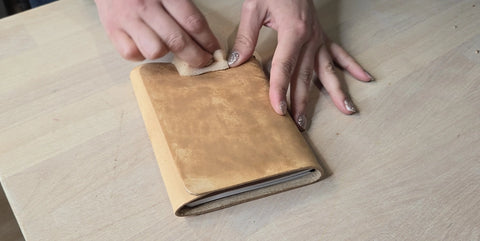 |
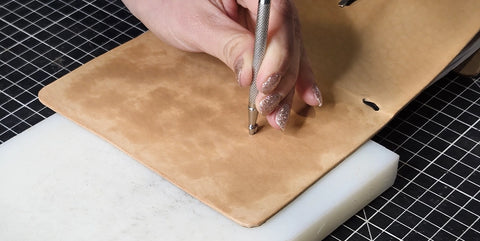 |
You're finished!
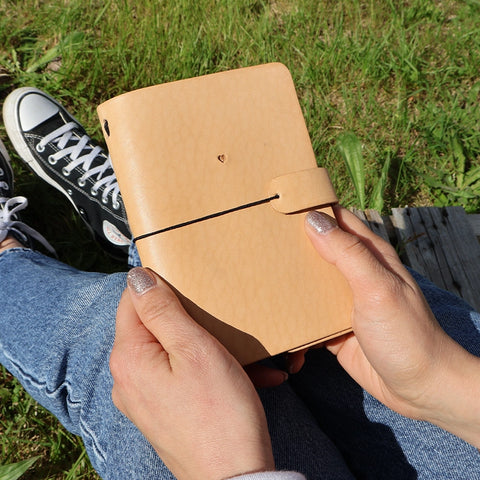 |
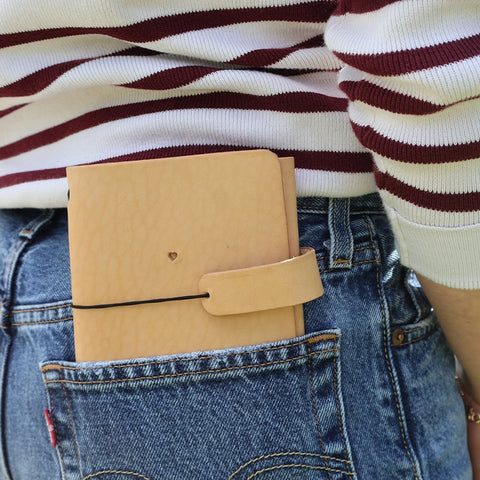 |
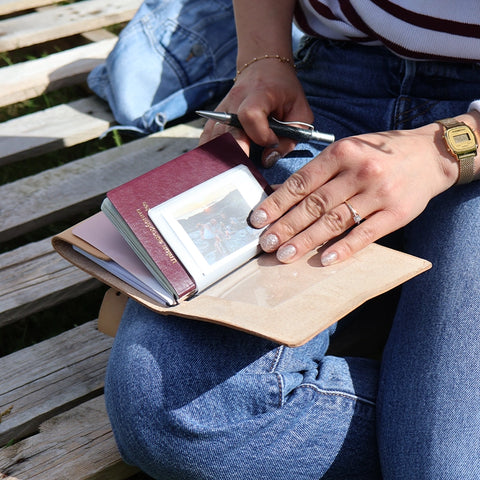 |
 |
Here is the result for an A5 notebook and leather from our SAUVAGE range:
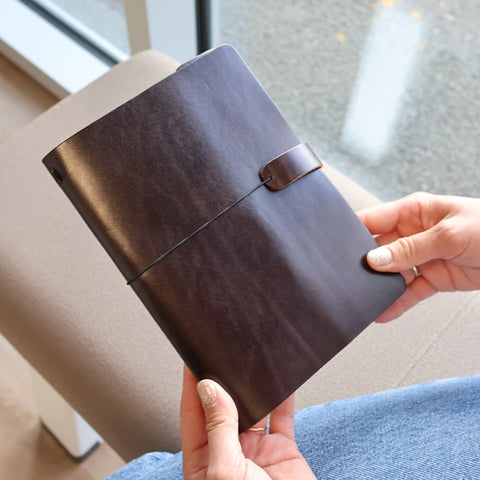 |
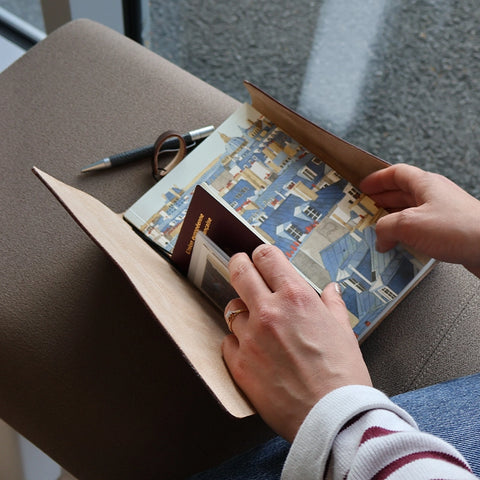 |
VERSION NO. 2 - WITH SEWN-IN FLAPS
This version allows you to tuck notebook/book or health record book covers into the flaps. This version can be sewn by hand or machine.
Book Cover Video
Video Health Record Protector
The necessary equipment
- One piece of leather approximately 1.2 mm/1.3 mm thick, medium-soft, medium-firm – Minimum size for a health record book or paperback: 30 x 40 cm. For our examples, we have selected leathers from the SATINATO and SATINLYS ranges.
- 1.5m of elastic cord - Diameter 1.5mm
- 1 leather loop clip
And the following equipment:
- 1 cutter
- 1 round cookie cutter, 3 mm in diameter
- Machine or hand sewing thread
1. Patronage
Calculating dimensions:
Height : height of the notebook/book + 1.4 cm (+7 mm at the top + 7 mm at the bottom).
Width : (notebook width × 2) + notebook thickness + 13 cm flap.
Example for a health record:
The health record measures 15 x 21 cm and is 0.7 mm thick.
For the height: 21 + 0.7 + 0.7 = 22.4 cm
For the width: 15 + 15 + 0.7 + 13 = 44 cm.
Our leather rectangle therefore measures 22.4 cm x 44 cm. This version fits perfectly into our 30 x 40 cm pieces (it is possible to reduce the size of the flaps or to select a hide of approximately 0.40 m2).
SMALL LEATHER TAB (on the front of the notebook).
There is also a second piece measuring 9 x 2 cm to be cut from the leather scraps.
Example for a 350-page paperback:
The book measures 11 x 18 cm and is 2 mm thick.
For the height: 18 + 0.7 + 0.7 = 19.4 cm
For the width: 11 + 11 + 2 + 13 = 37 cm
Our leather rectangle therefore measures 19.4 cm x 37 cm. This version fits into our 30 x 40 cm pieces.
SMALL LEATHER TAB (on the front of the notebook).
There is also a second piece measuring 13 x 2 cm to be cut from the leather scraps.
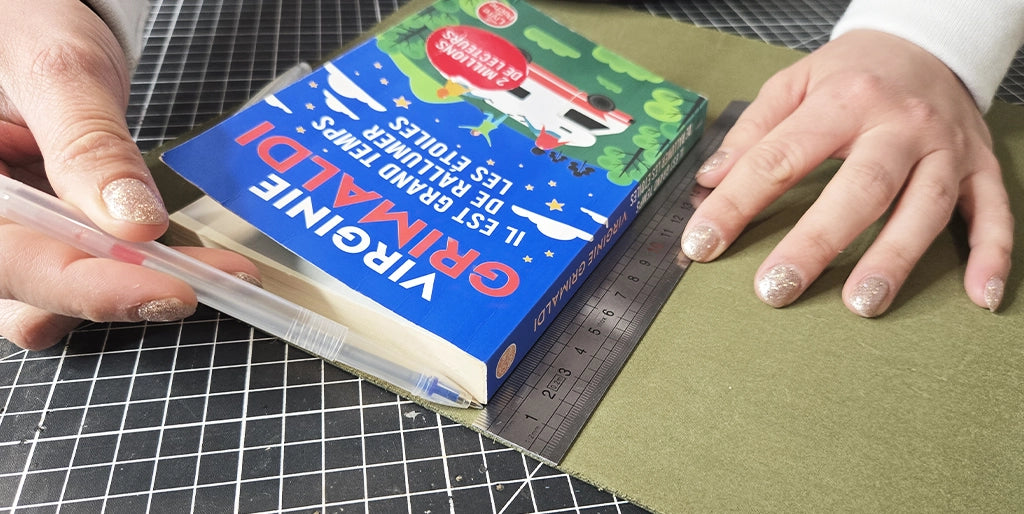
2. Cut the leather
Cut out the main rectangle according to the calculated dimensions, then cut the tab from the remaining scraps.
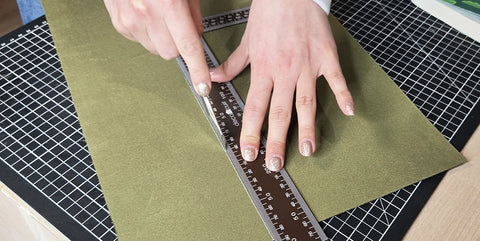 |
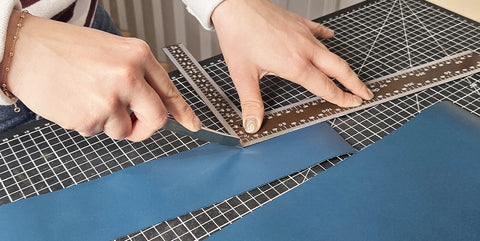 |
3. Form the flaps
Mark two points: one at 6 cm and another at 12 cm, at each end of the main piece. Carefully check that the flap lengths are correct by positioning the book or notebook before gluing.
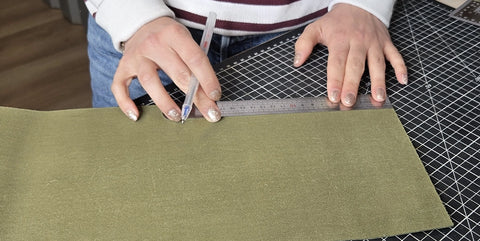 |
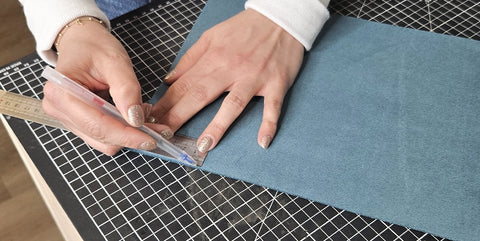 |
Form the folds using a smoothing tool and a ruler / a set square.
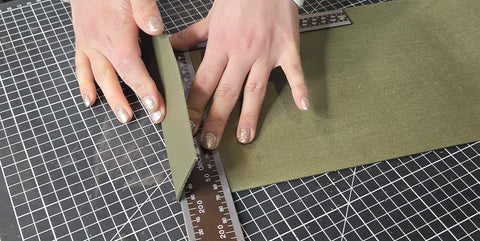 |
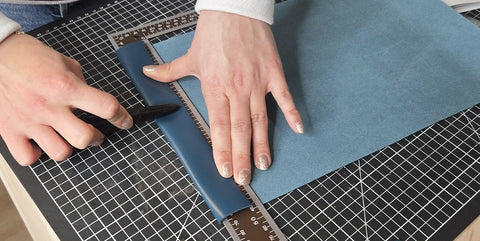 |
Apply contact adhesive to the 6 cm of the fold and to the following 6 cm, so that there is adhesive on both sides to be assembled.
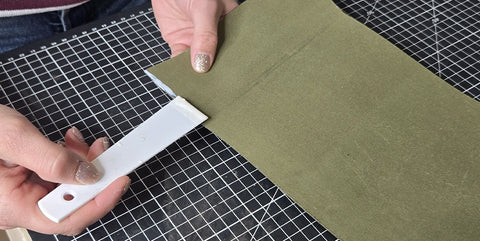 |
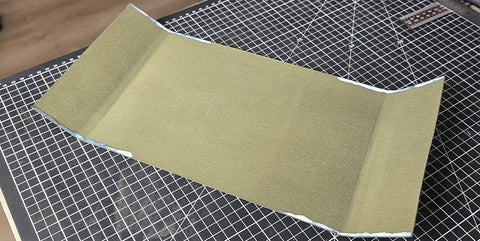 |
Form the flap by folding the leather over approximately 6 cm on each side.
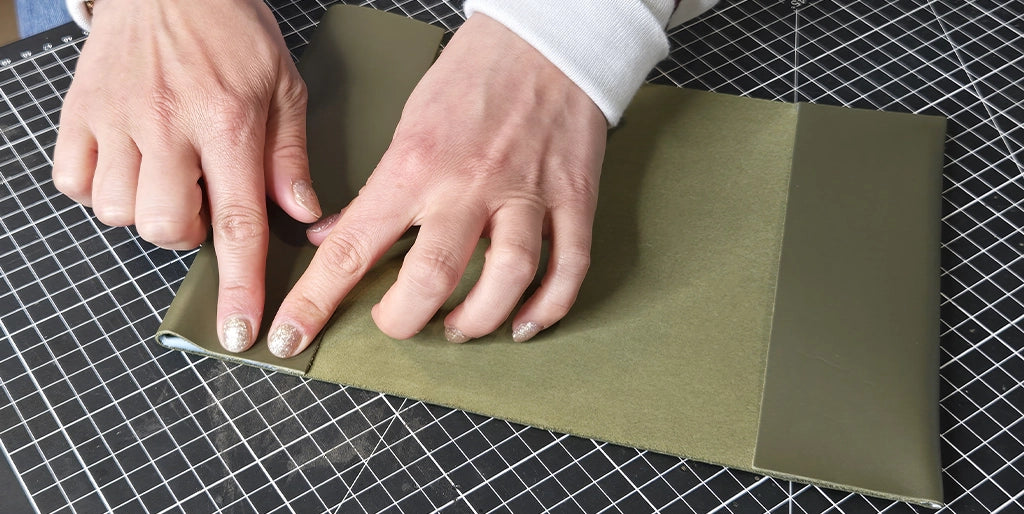
4. Sew the lengths
Sew the top and bottom lengths of the notebook cover 3/4 mm from the edge maximum.

Also, add a decorative stitch all around the tab, 3/4 mm from the edge. This tab can be reinforced (leather on both sides) for added strength.
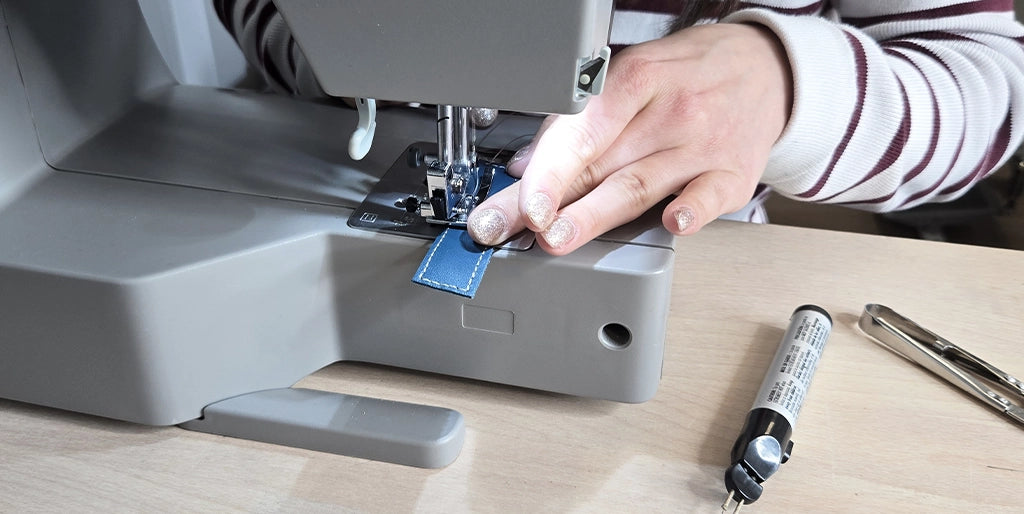
5. Attach the elastic band
Close the notebook or book cover, then mark a dot in the center of the back.
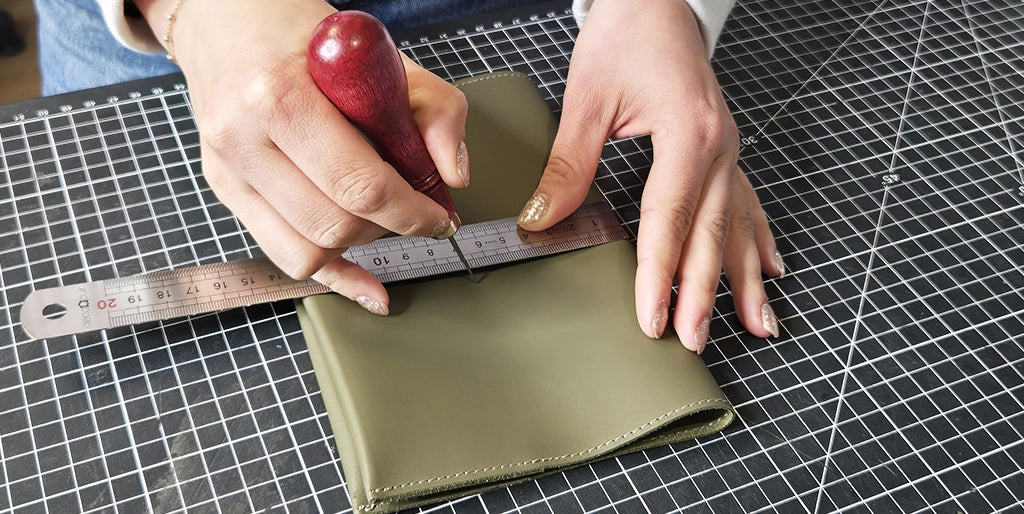
Drill a 3 mm diameter hole at this location.
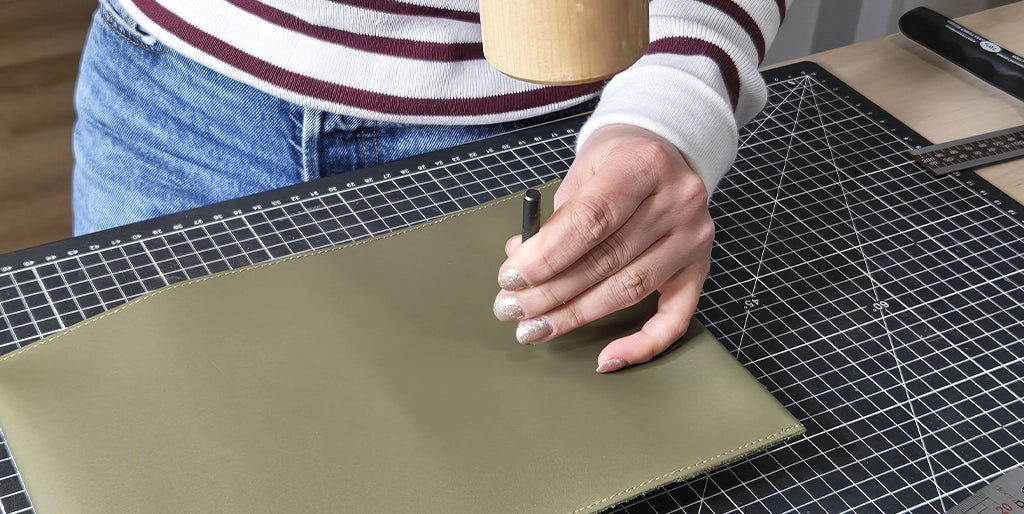
Mark the position of the staple prongs on each side of the Ø 3 mm hole.
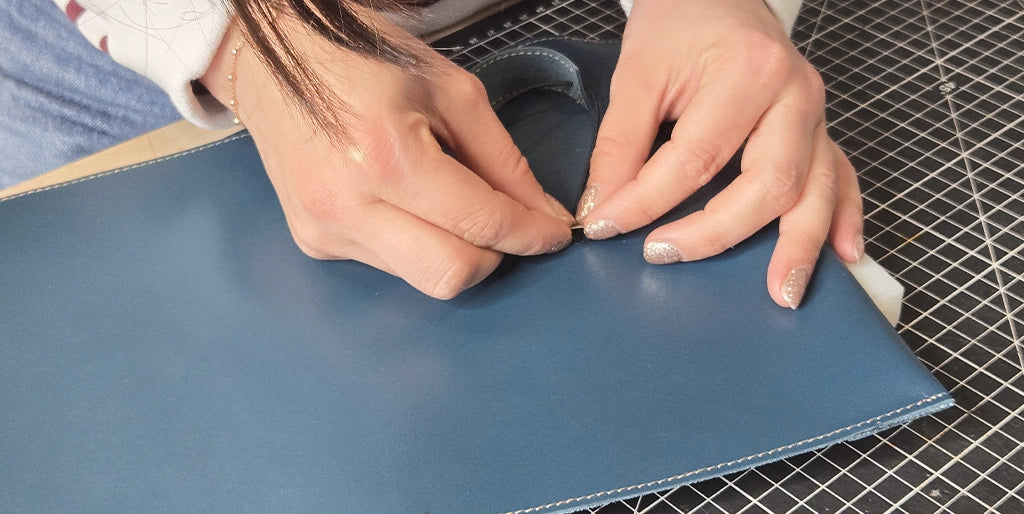

Then make 2/3 mm slits at the markings with a cutter.
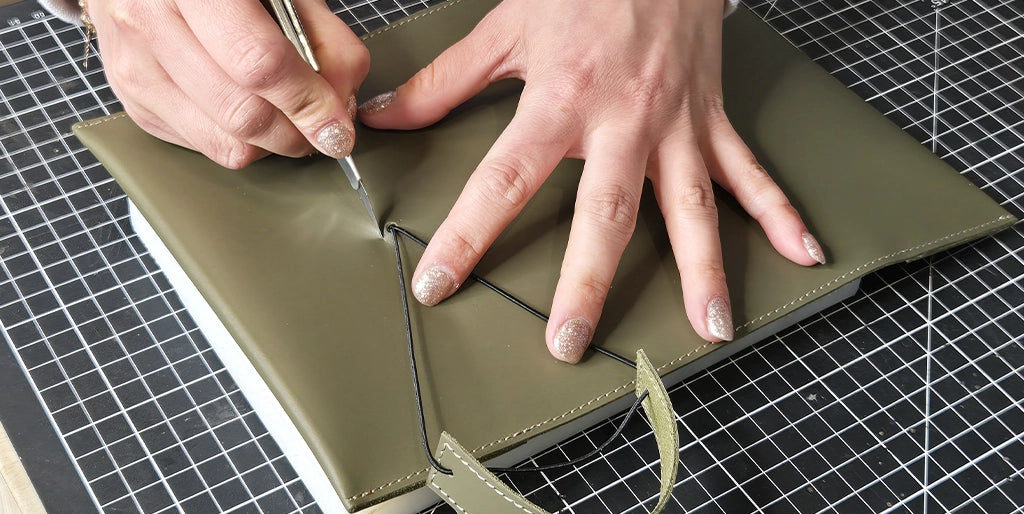
Take the tab and drill a Ø 2 mm hole at each end.
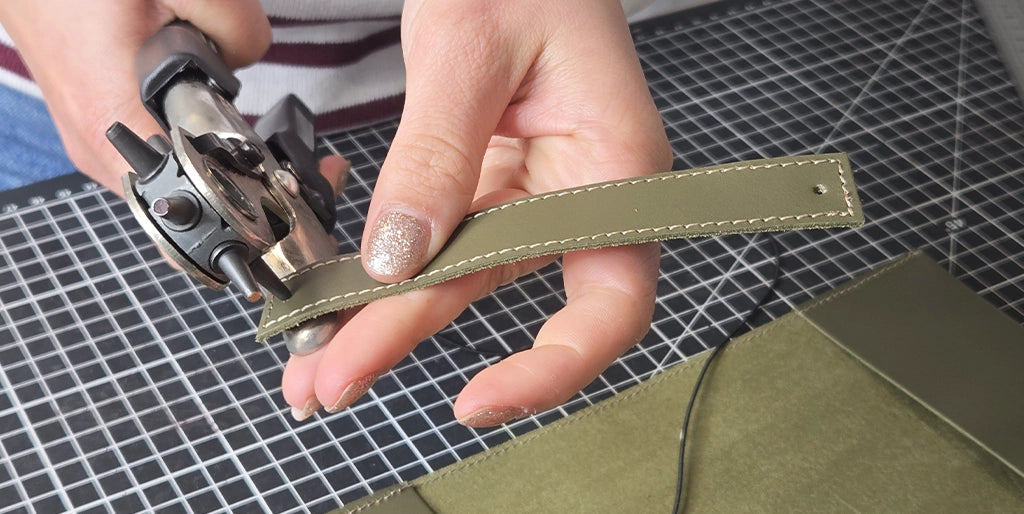
Take an elastic band of about 40 cm and pass it through the holes at the ends of the leather tab.
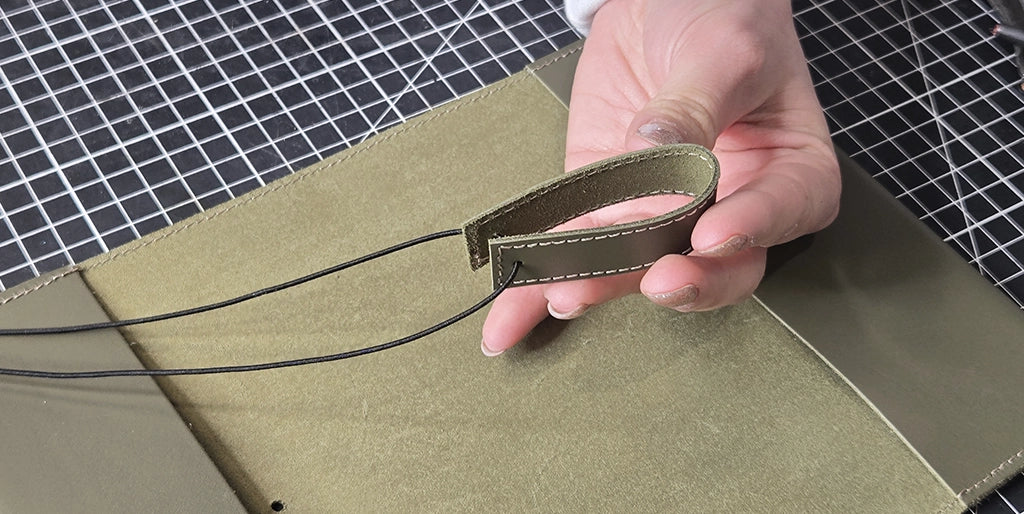
Fold the elastic in half, then pass it through the back hole, making sure that both ends come out inside the notebook.
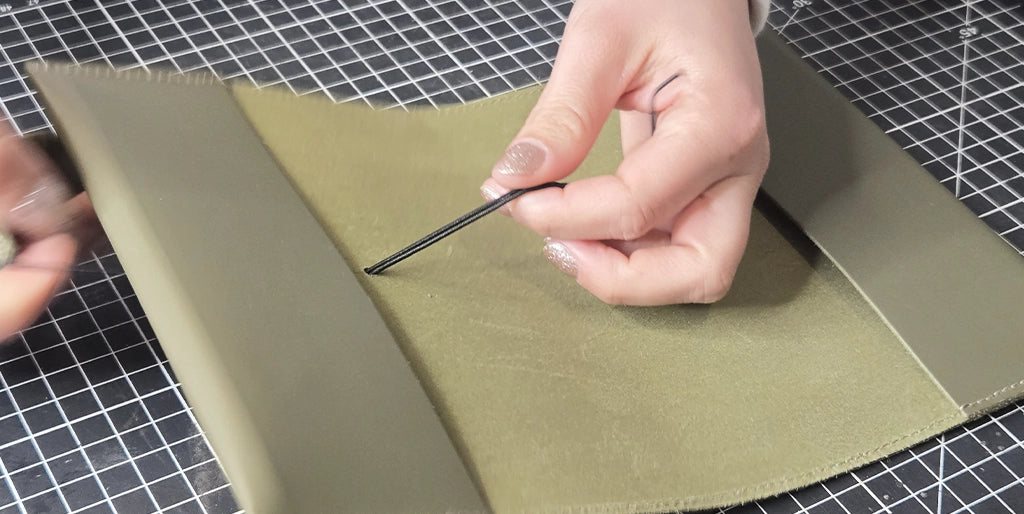
Insert the notebook/book into the notebook cover. Tie a loose knot at the end of the elastic and check the size by closing the notebook. Adjust the elastic to the correct length and tie a tight knot.
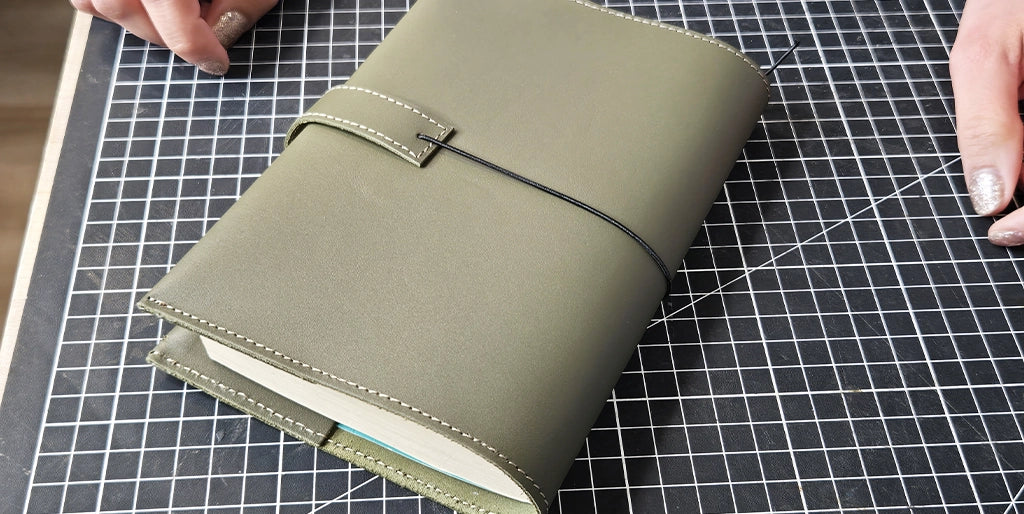
Insert the staple into the slots made earlier, then fold down the tabs, tucking the elastic underneath.
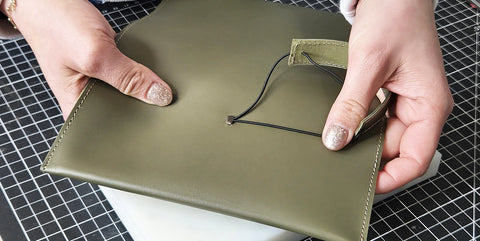 |
 |
Cut off the excess elastic.
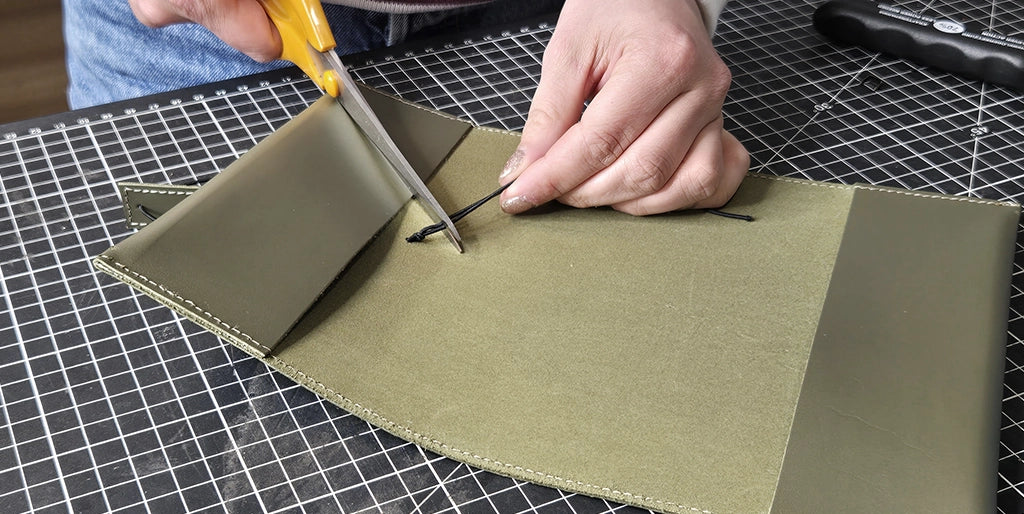
6. Put the middle elastic band
On the spine of the notebook: mark a first dot 1 cm from the edge, then a second 2 cm from the edge. Do the same for the bottom of the notebook: a first dot at 1 cm and a second at 2 cm.

Drill Ø 3 mm holes at these locations.
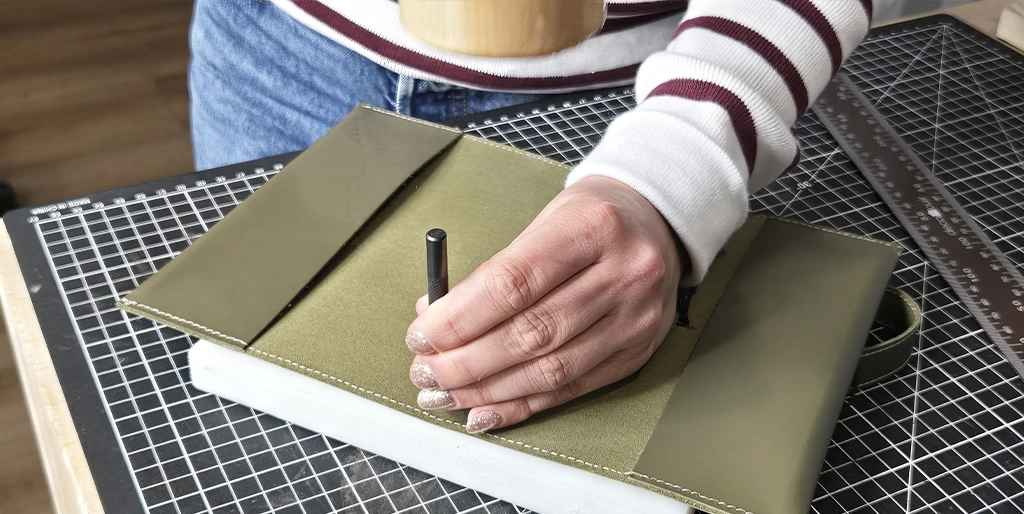
Take 40 cm of elastic. Pass the elastic through the first hole (from the inside), then through the second hole. Go to the third hole and out through the last hole. Bring the two ends of the elastic together and tie a double knot.
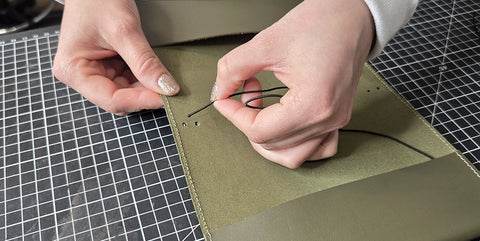 |
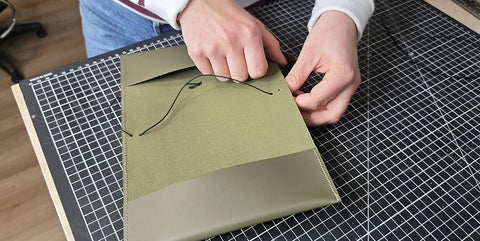 |
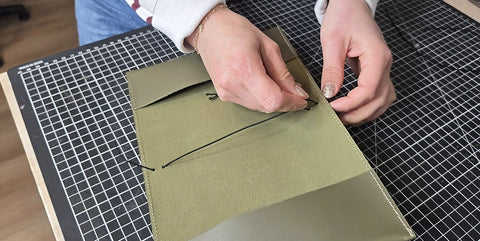 |
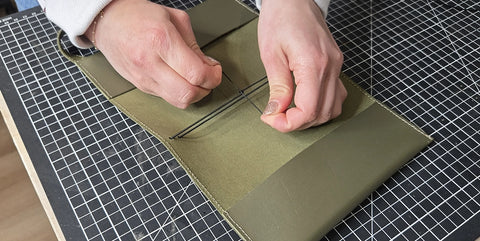 |
Add several elastic threads depending on the number of items to be fixed in the notebook (in our examples, we used 2 elastics of 40 cm).

11. OPTION: customization
Personalize the notebook with a marking, either on the tab, or on a small piece of vegetable-tanned leather.
SEE THE LEATHER MARKING GUIDE >
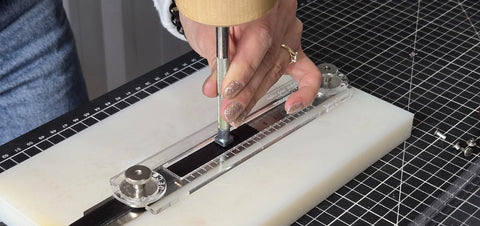 |
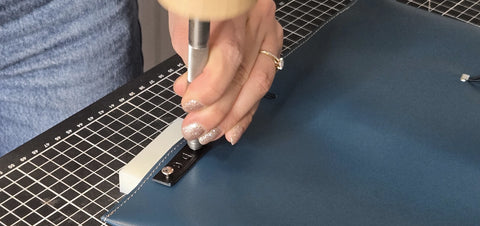 |
To be able to "carry" a health insurance card, we slipped a transparent card holder into our notebook covers:
You're finished!
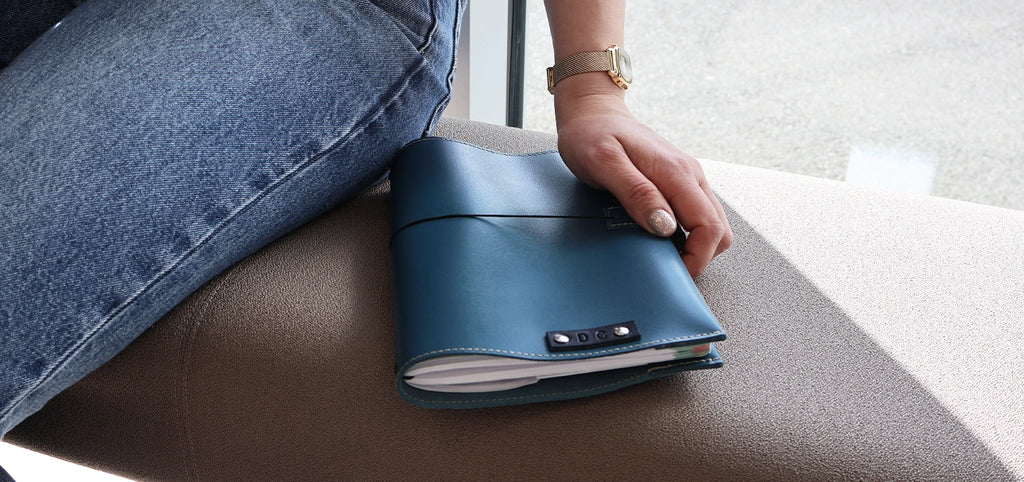
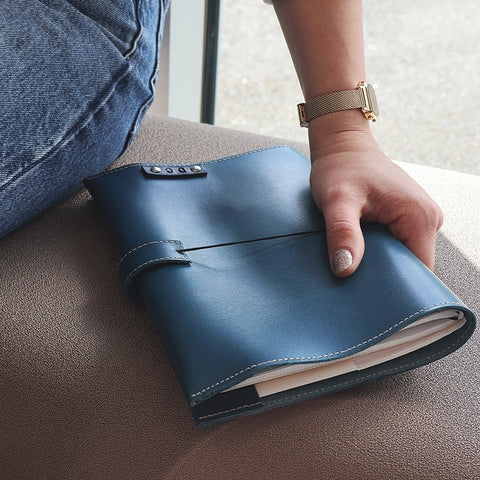 |
 |

 |
 |
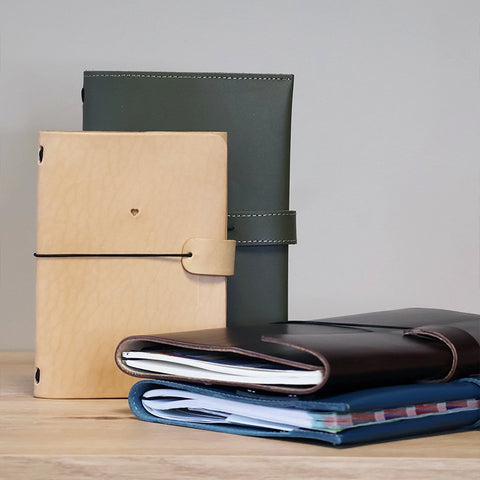 |
 |


